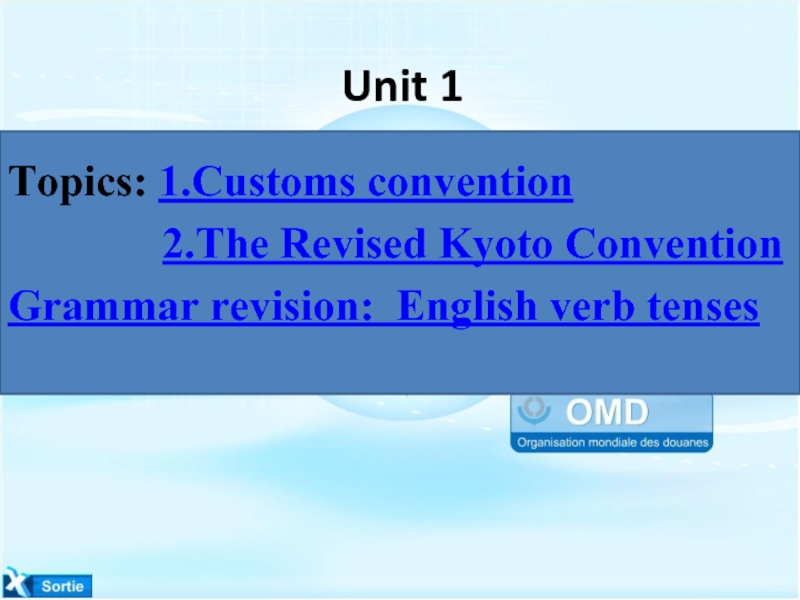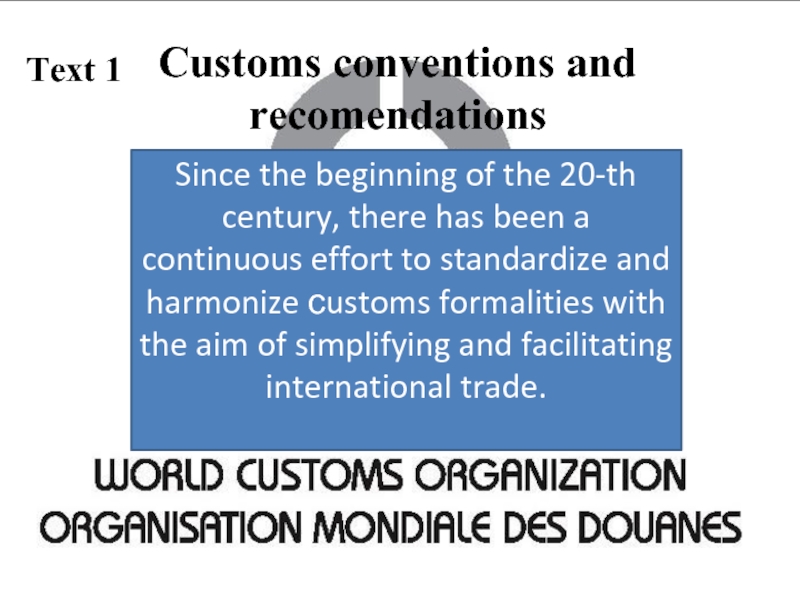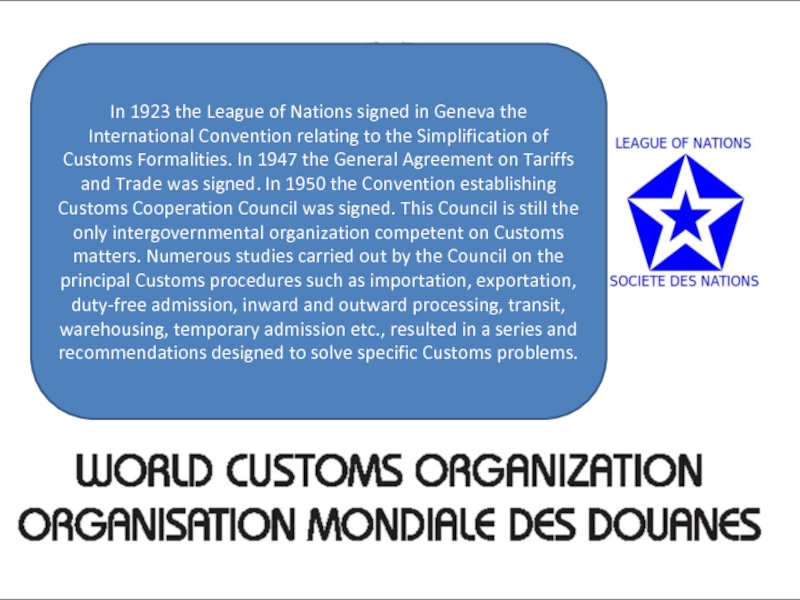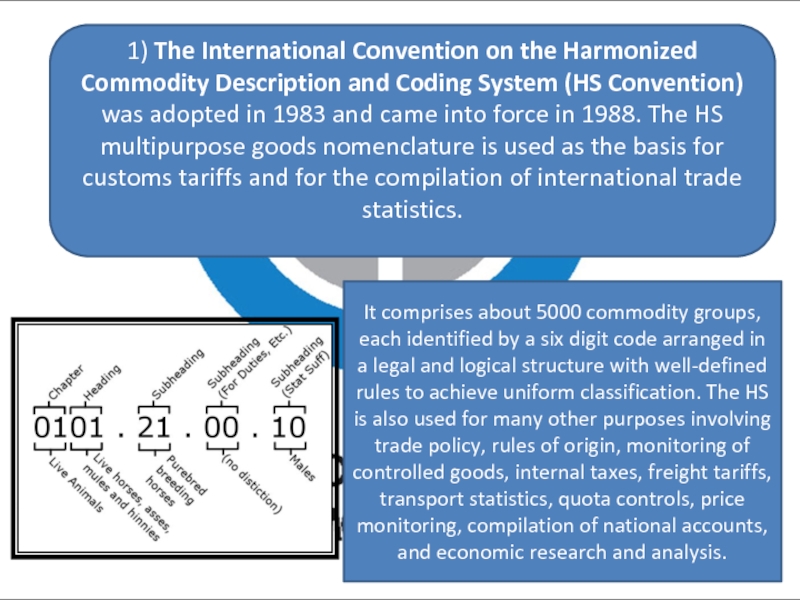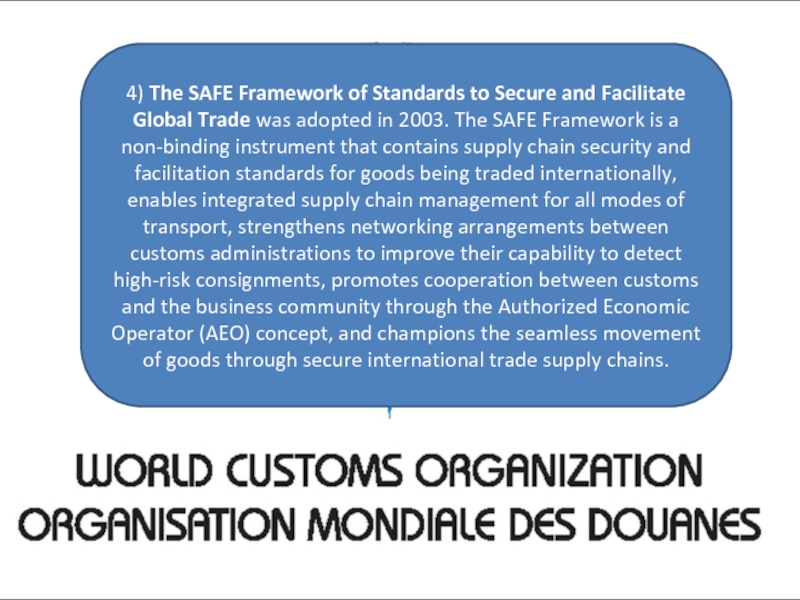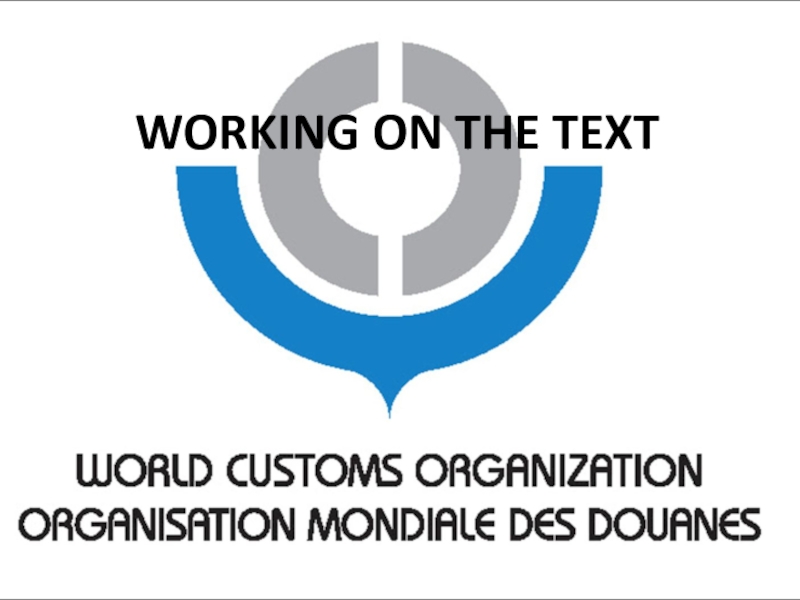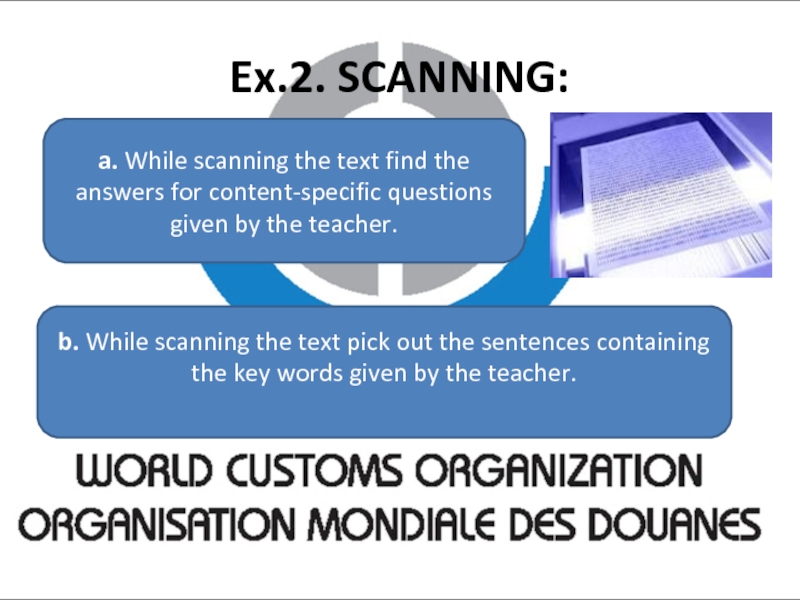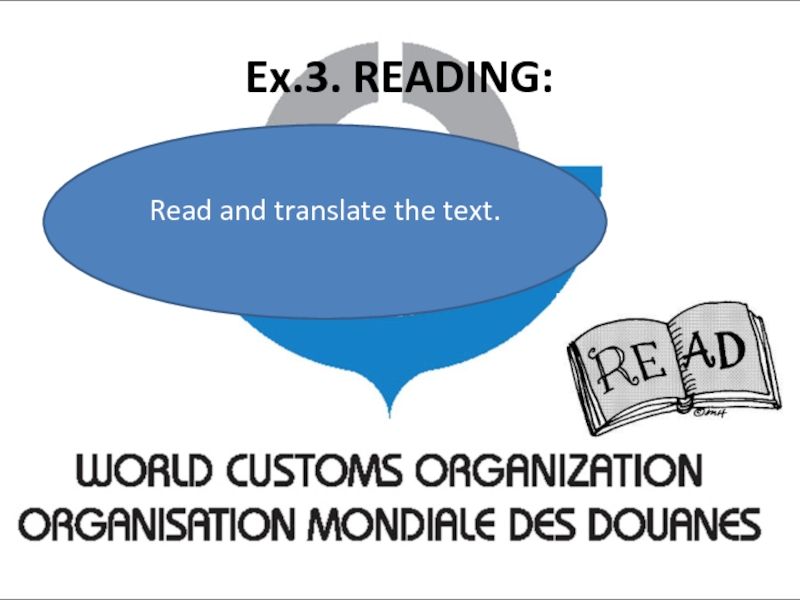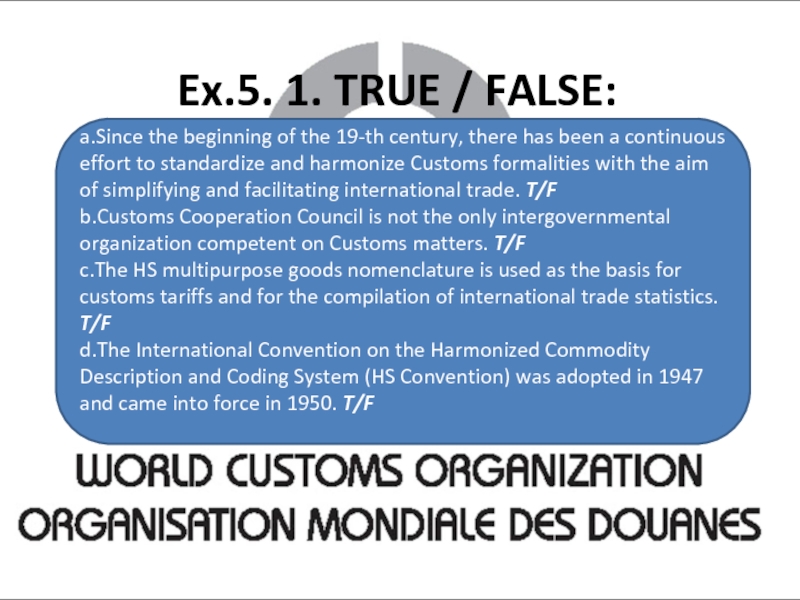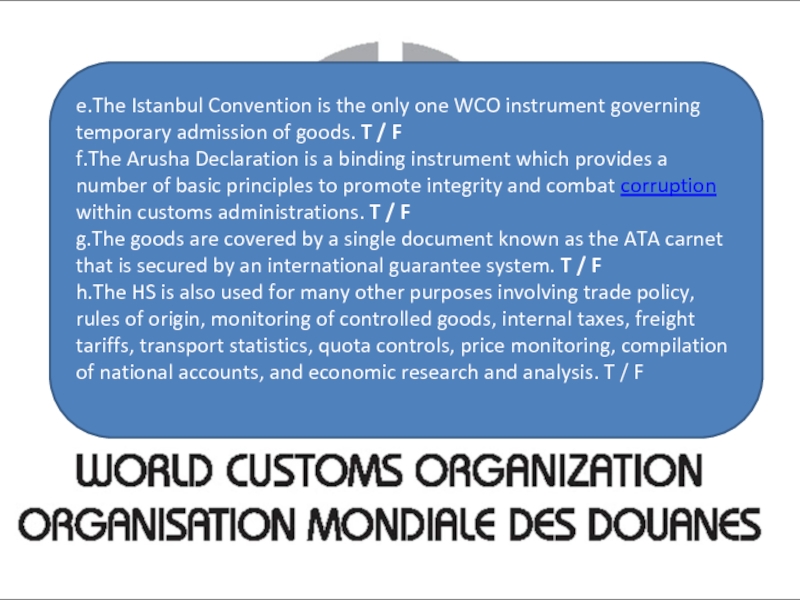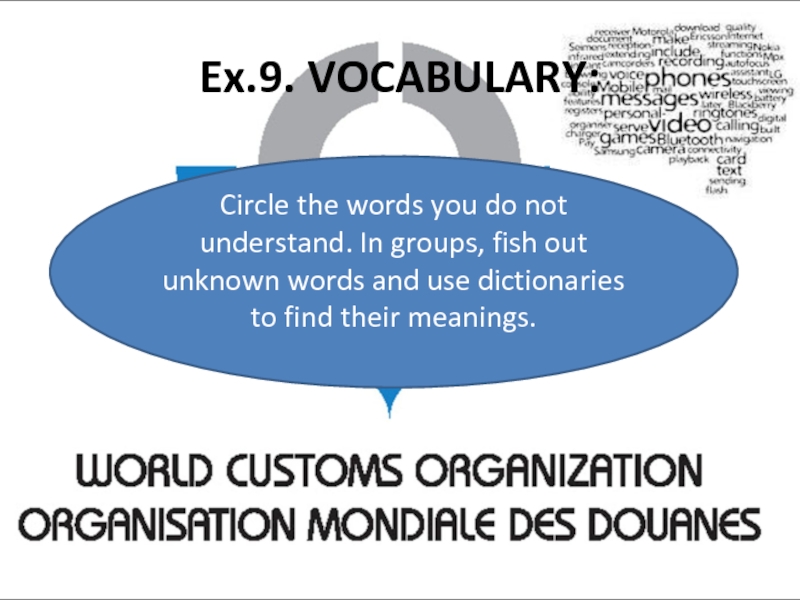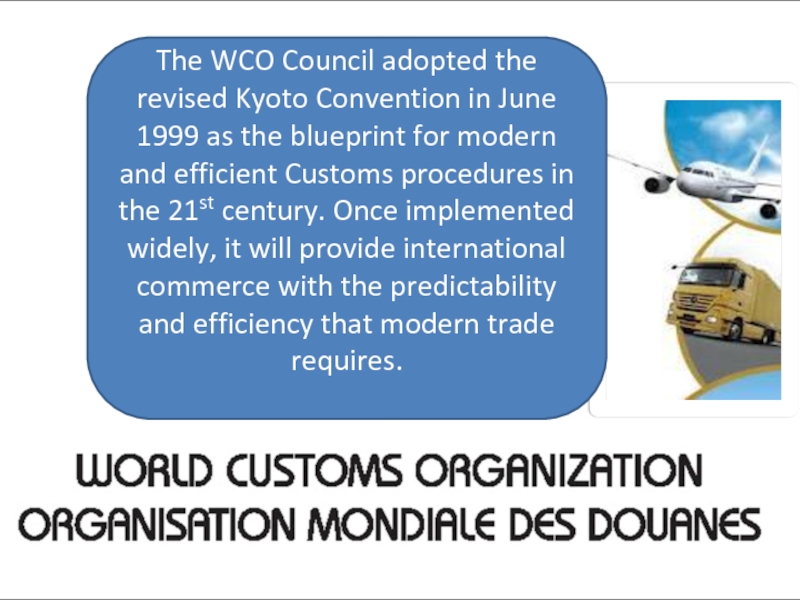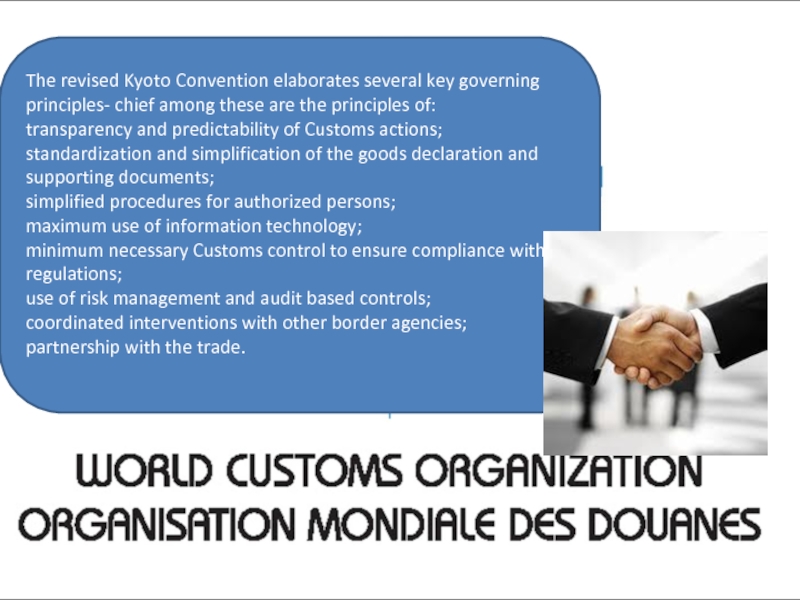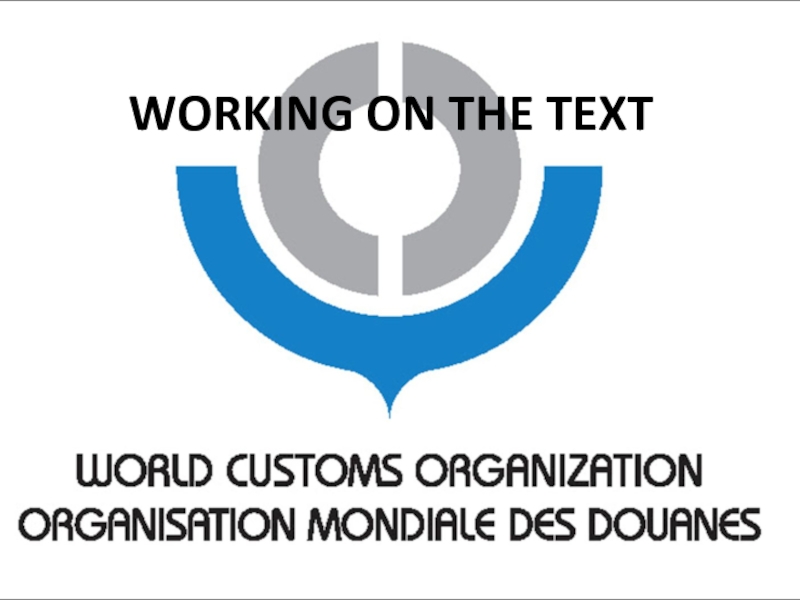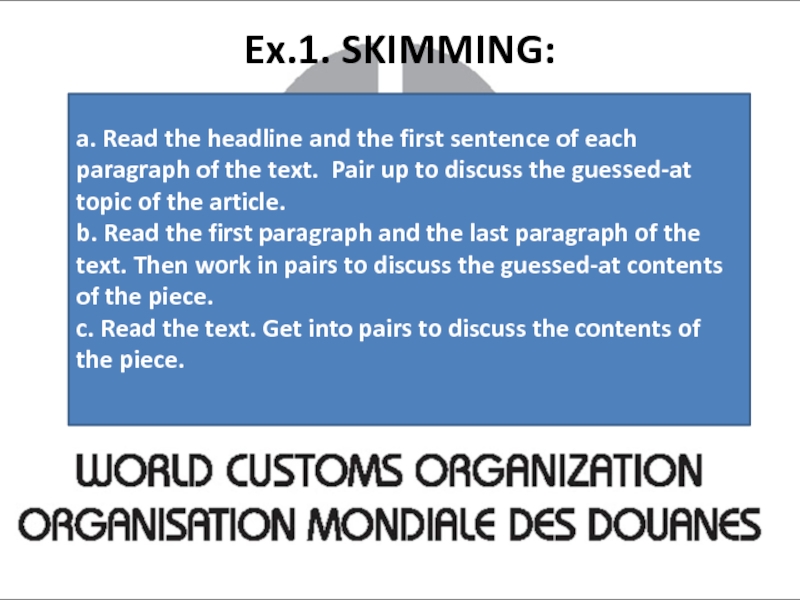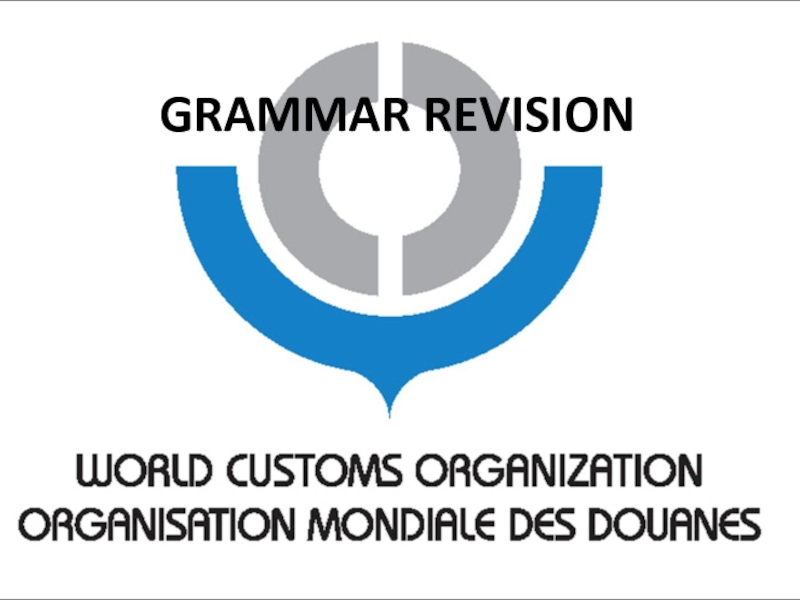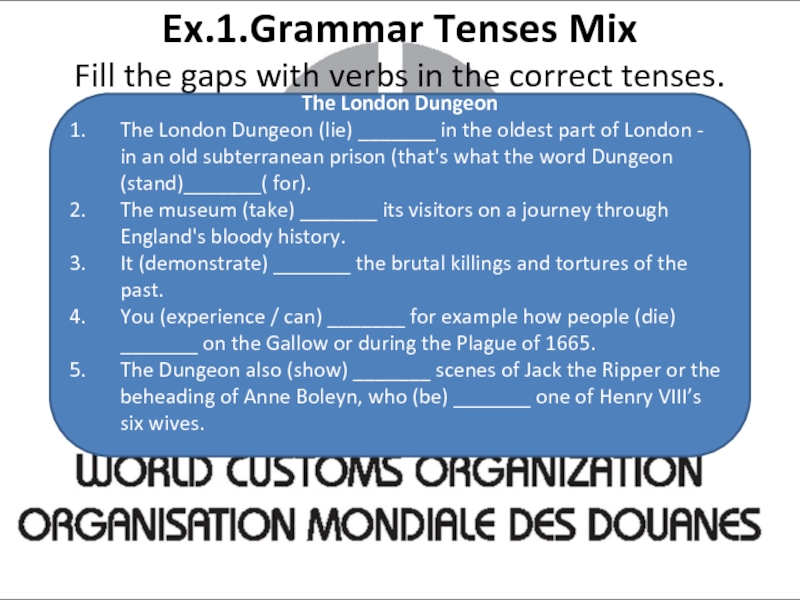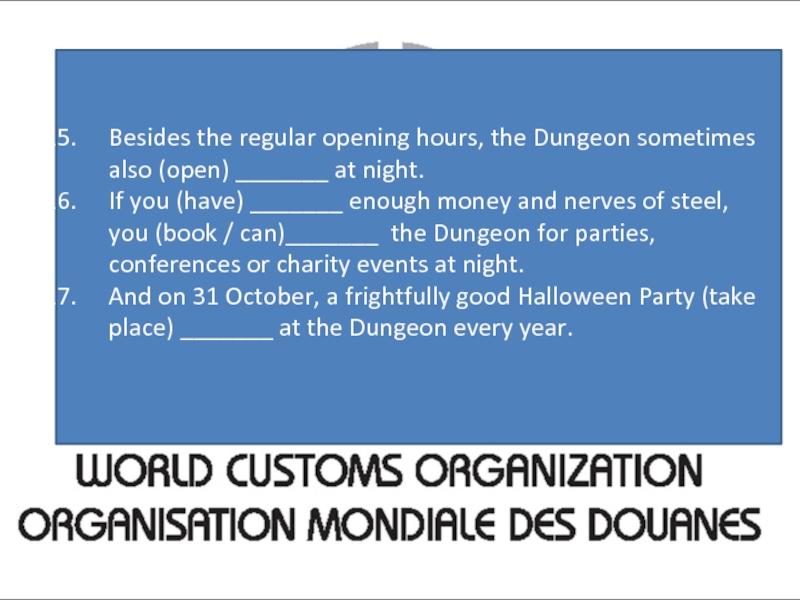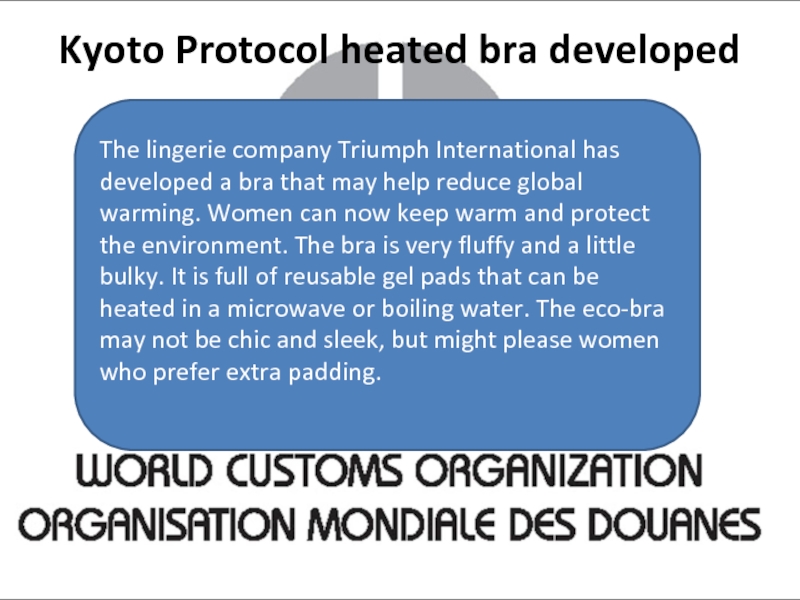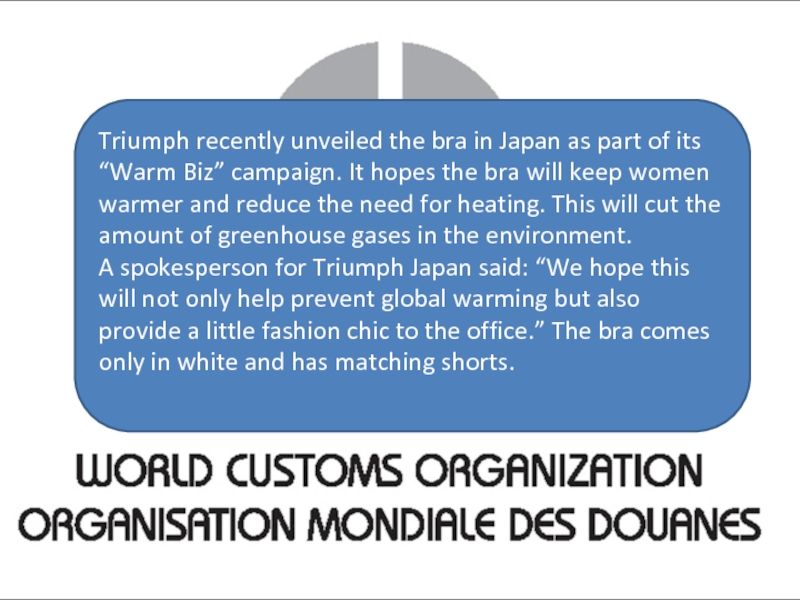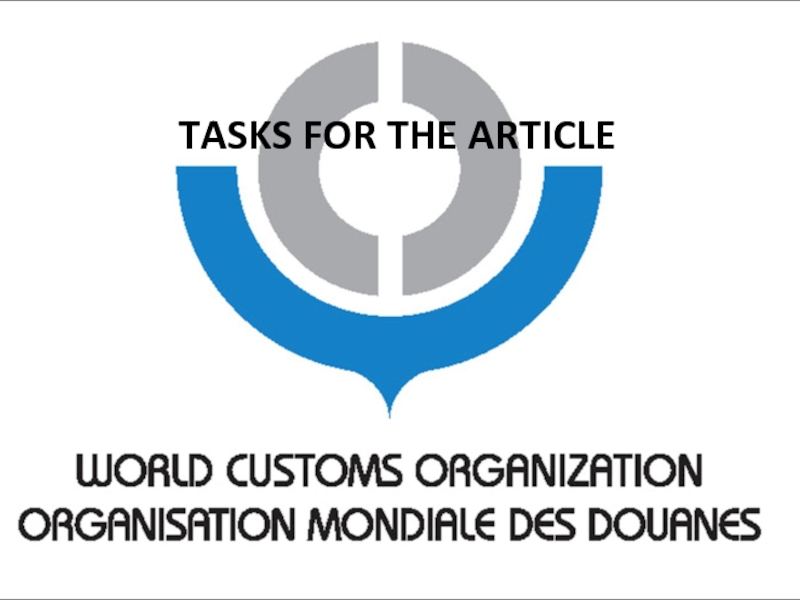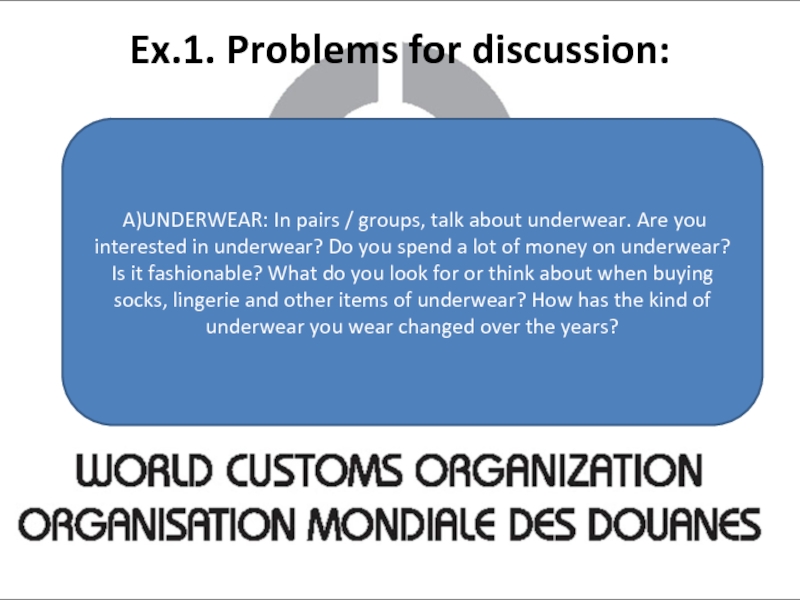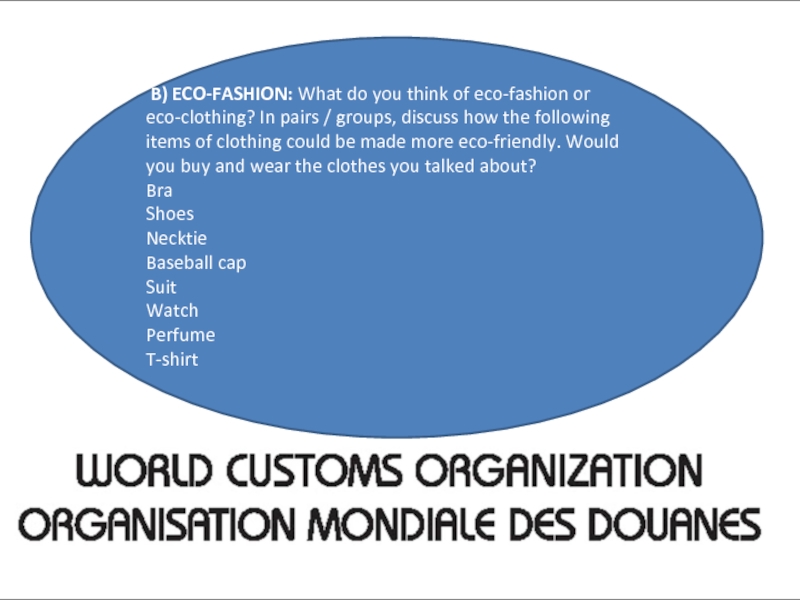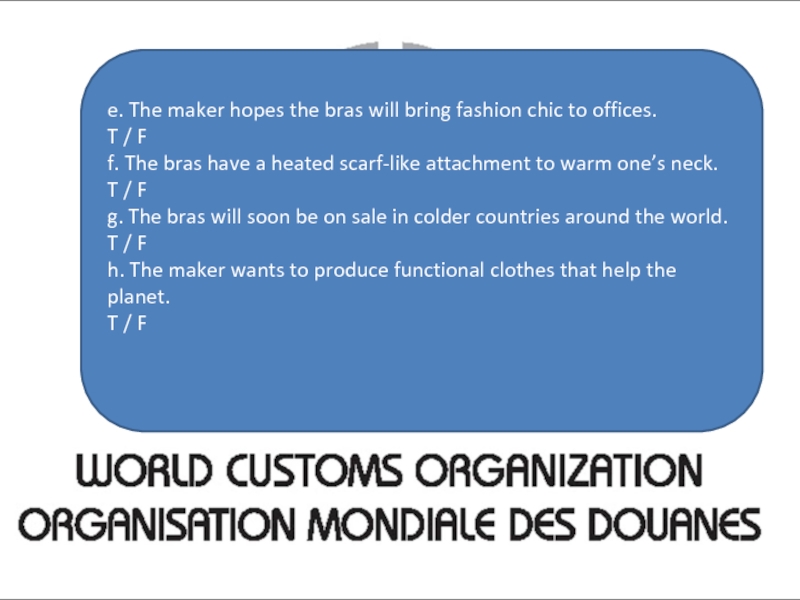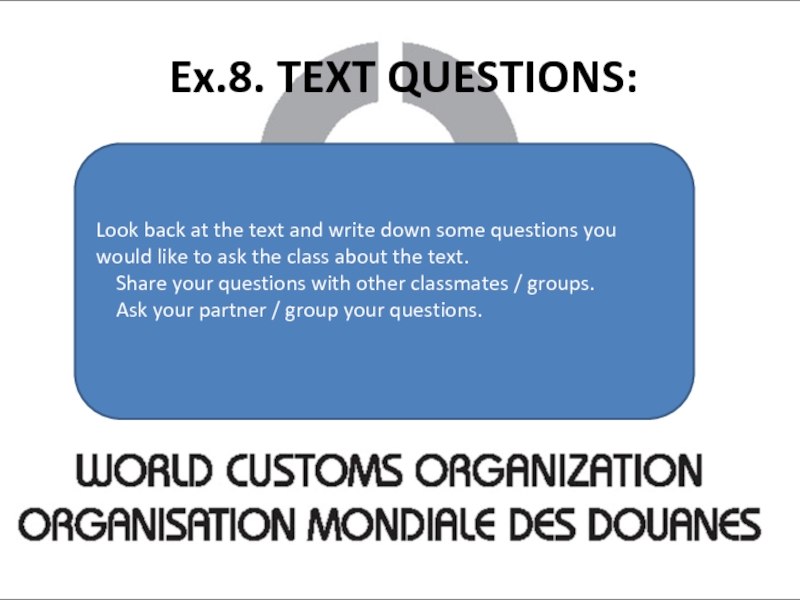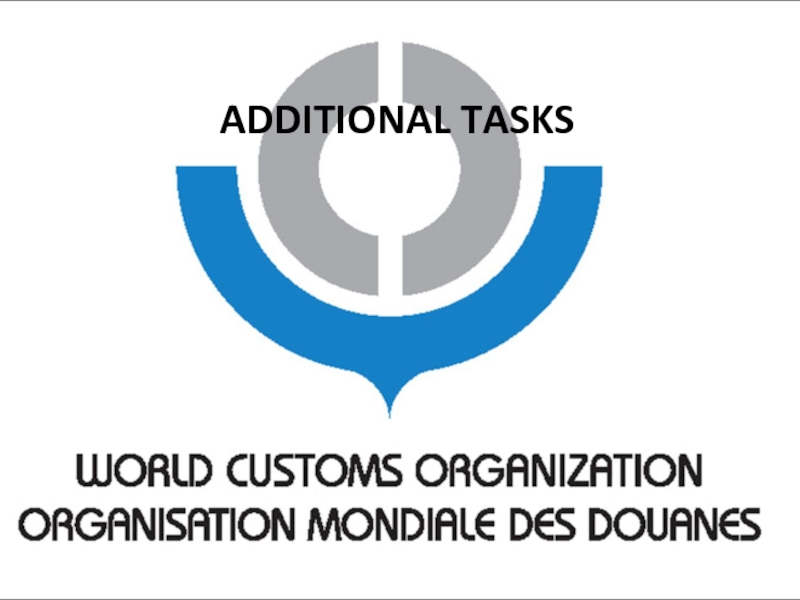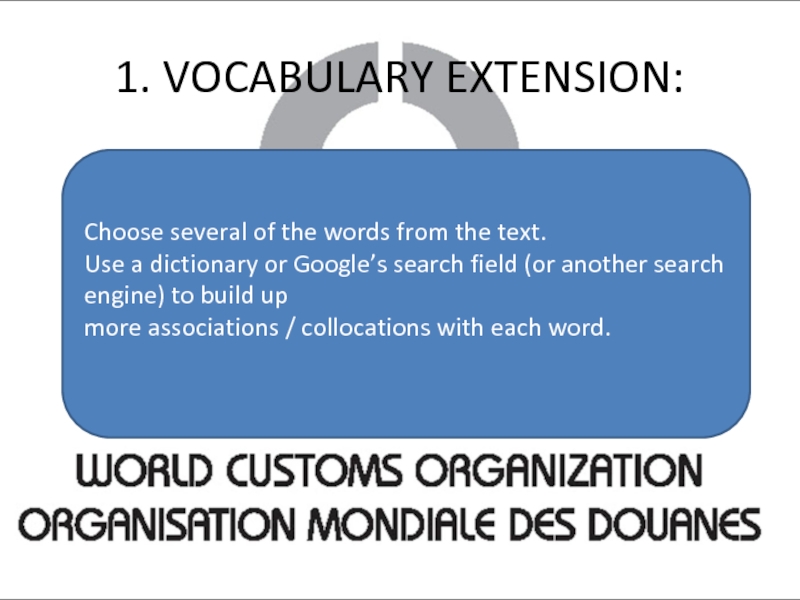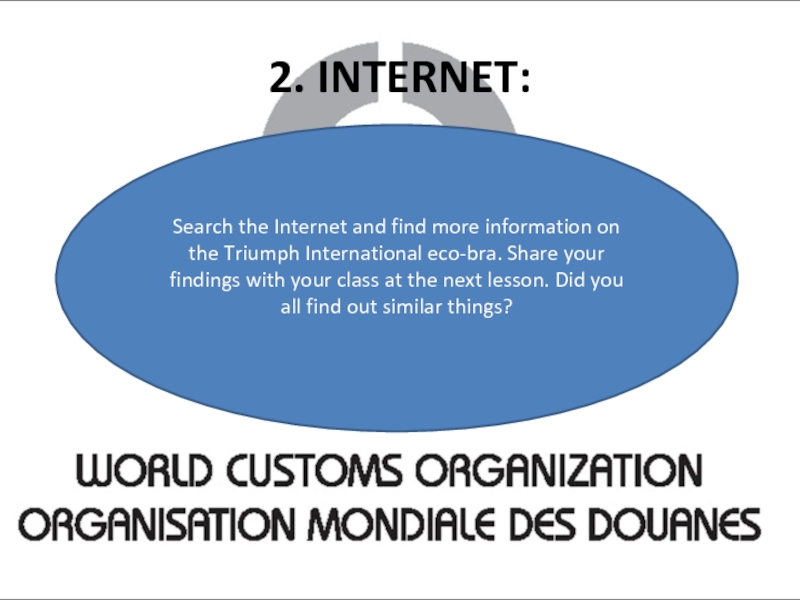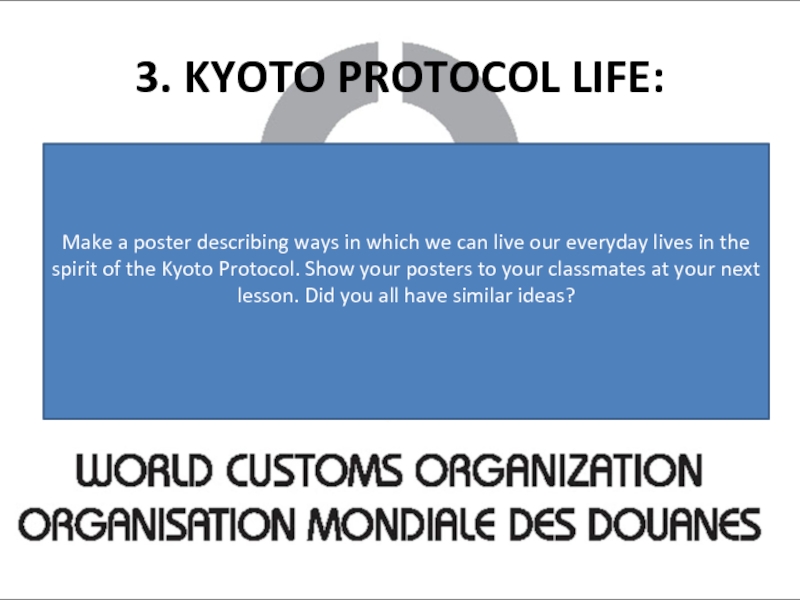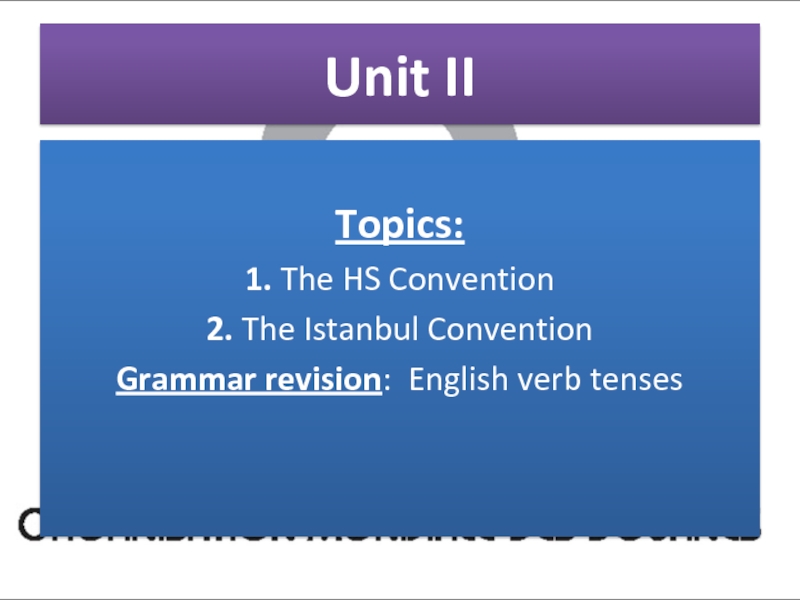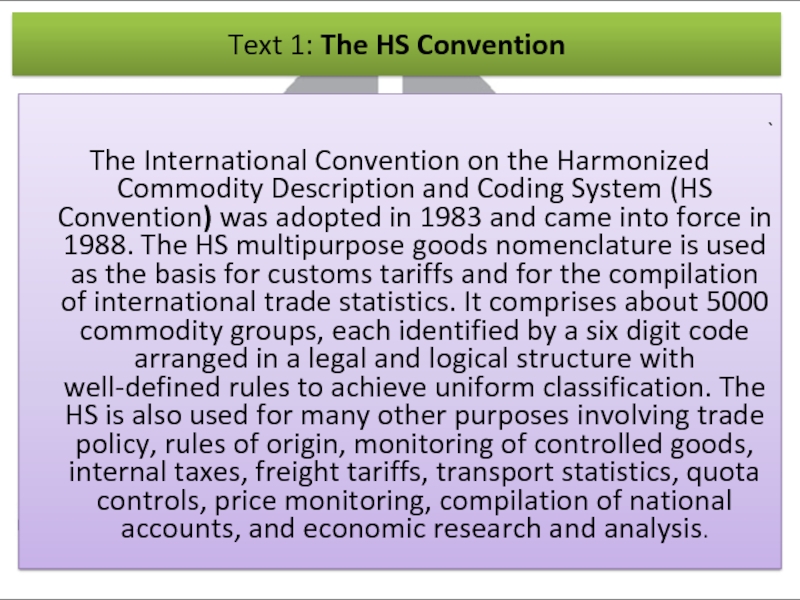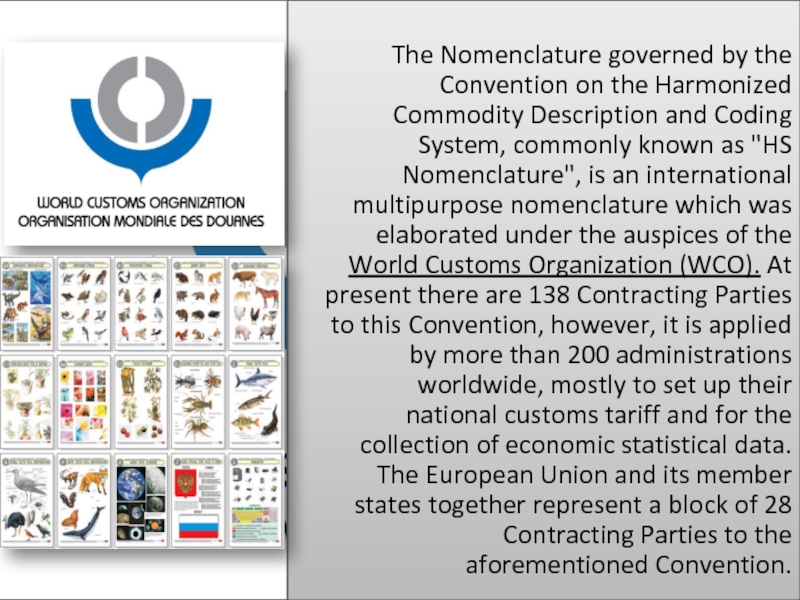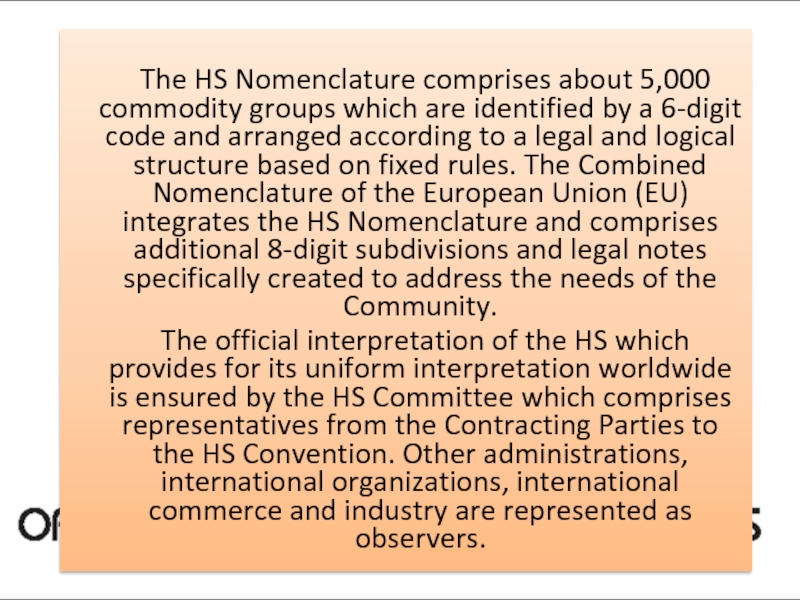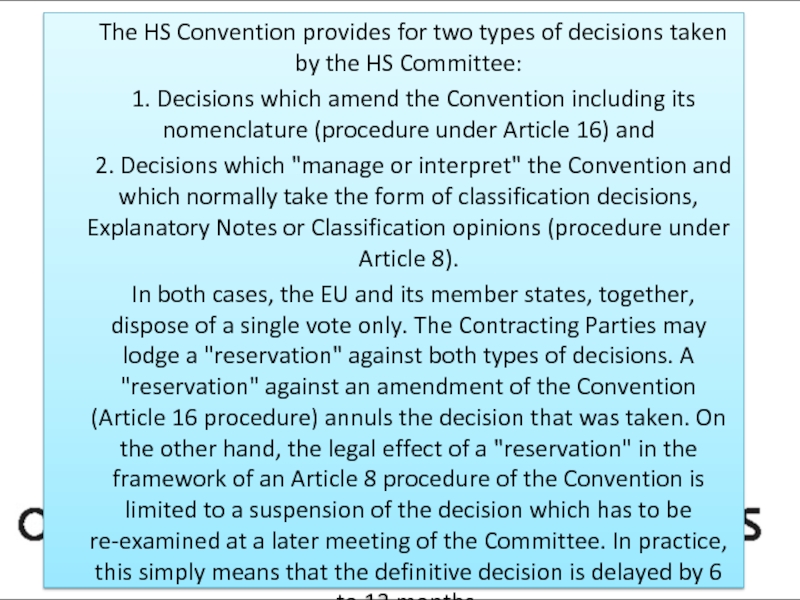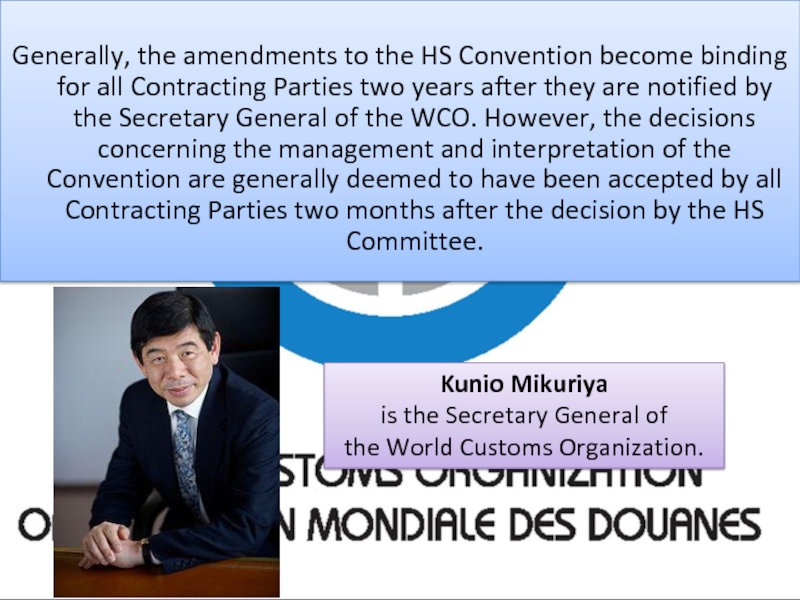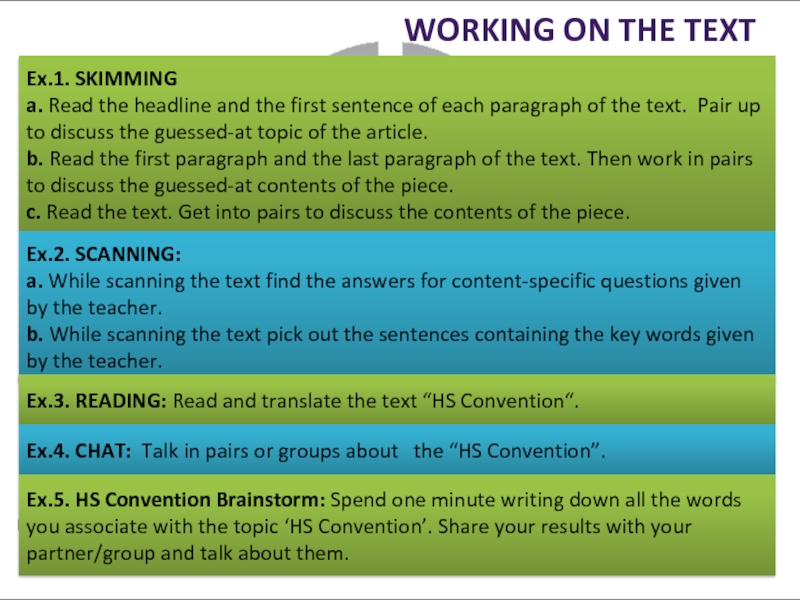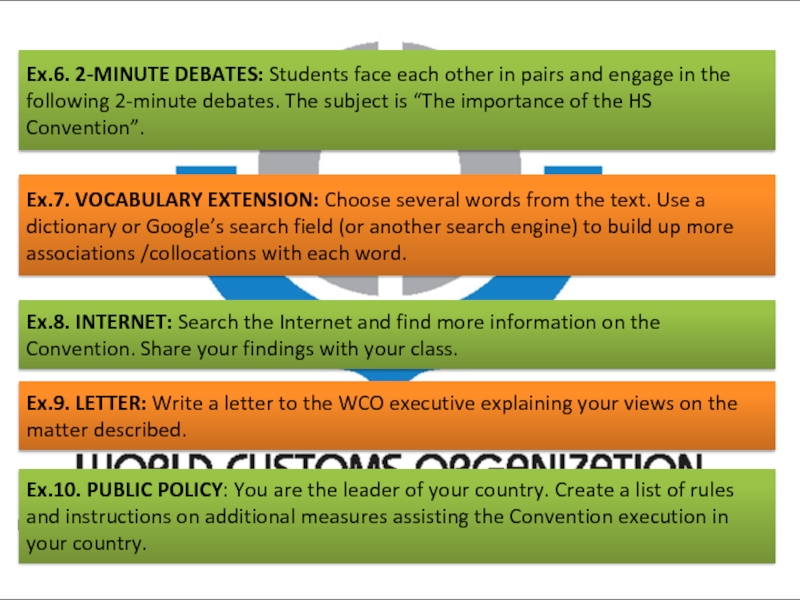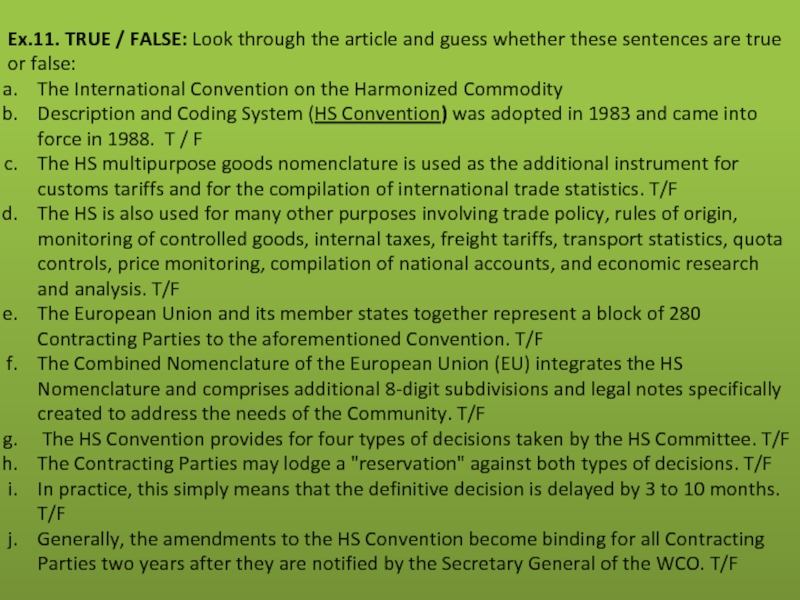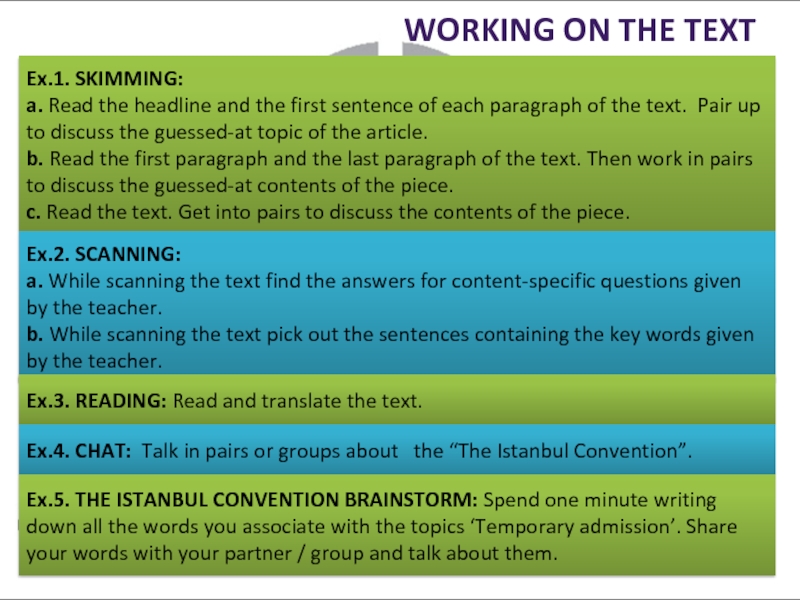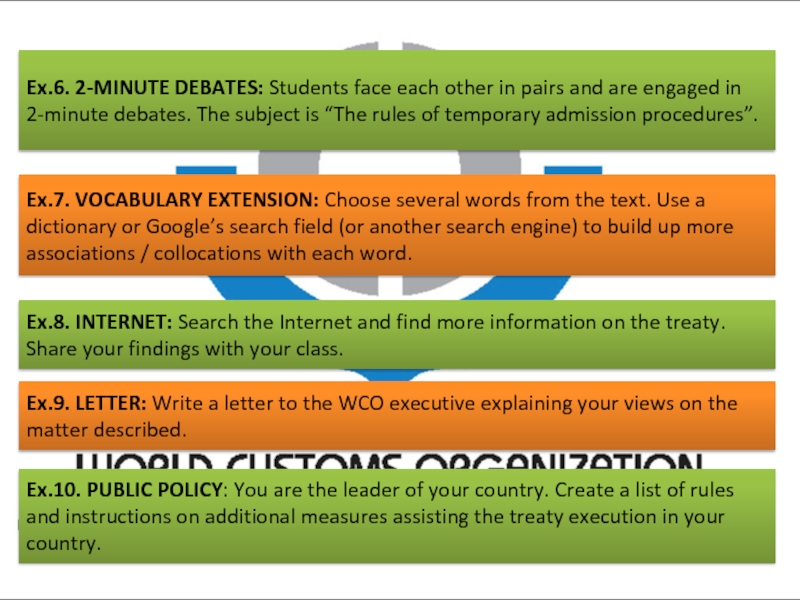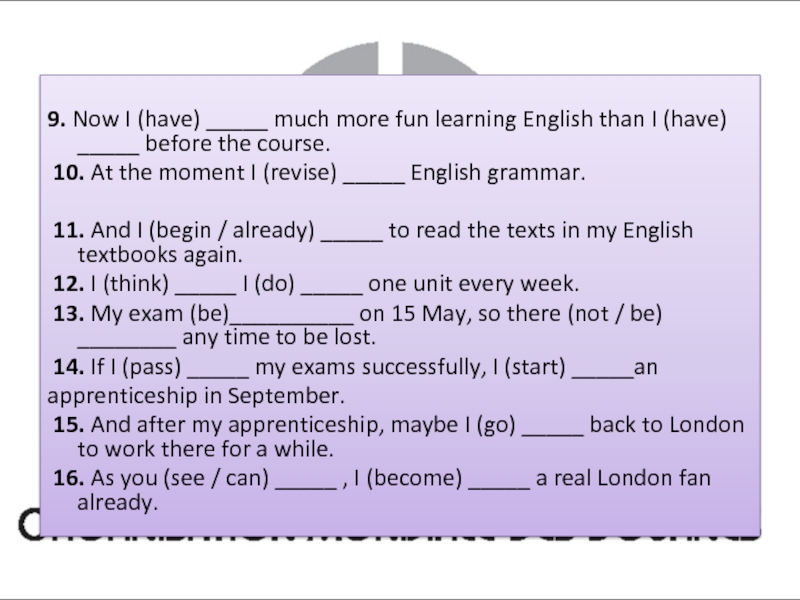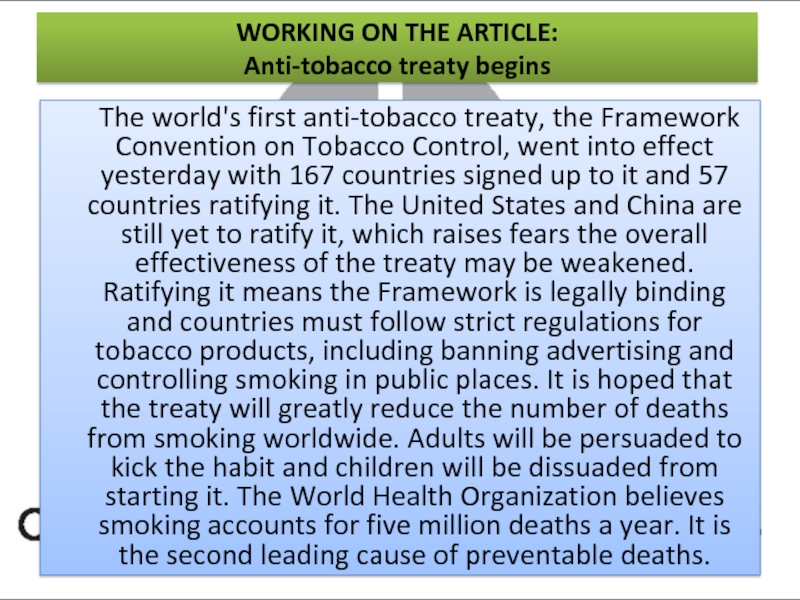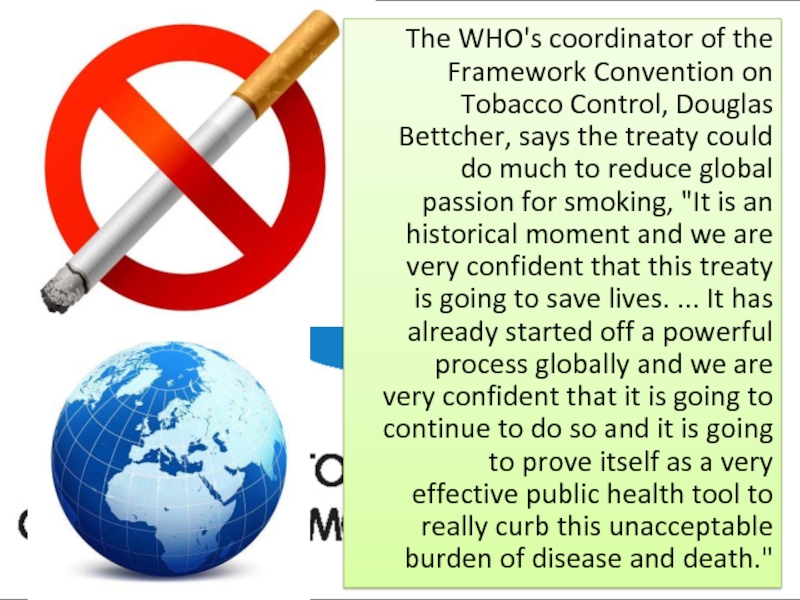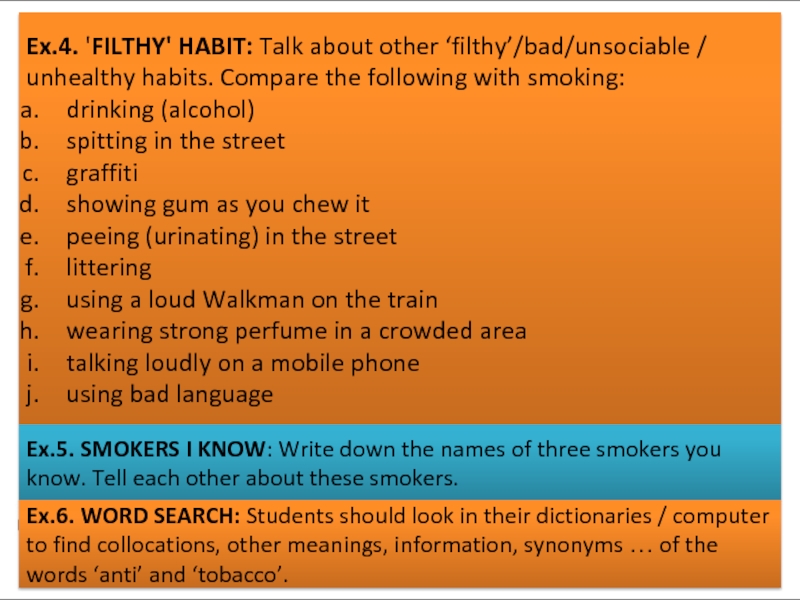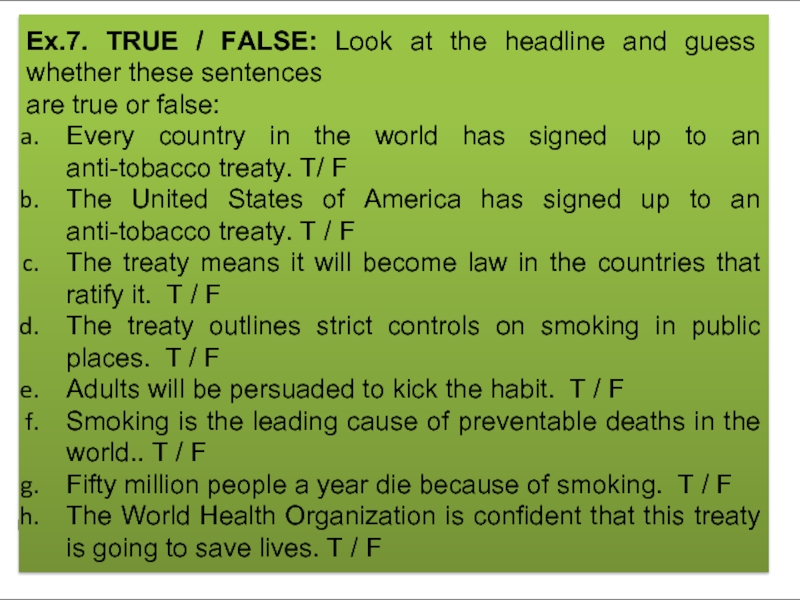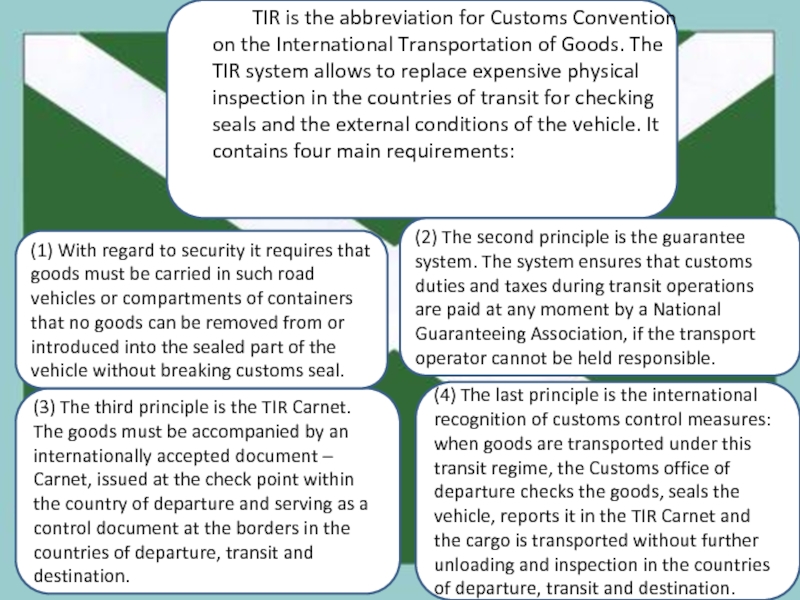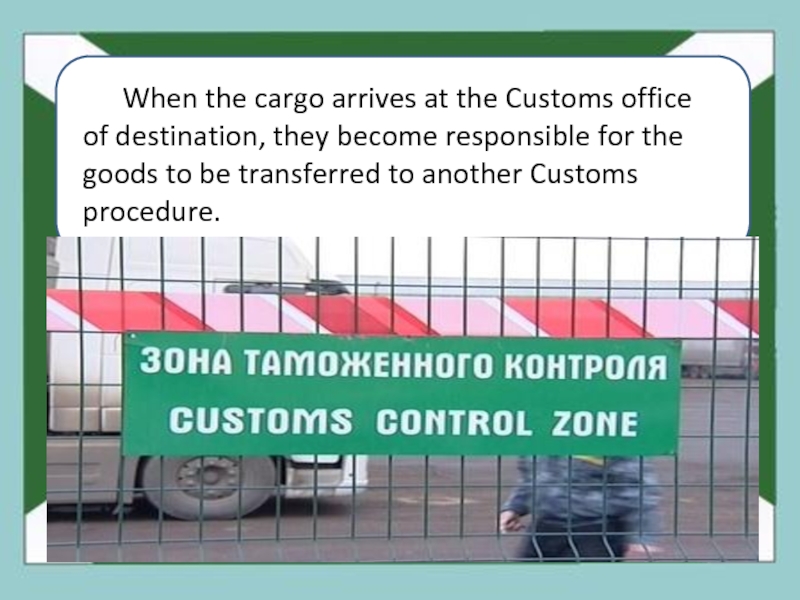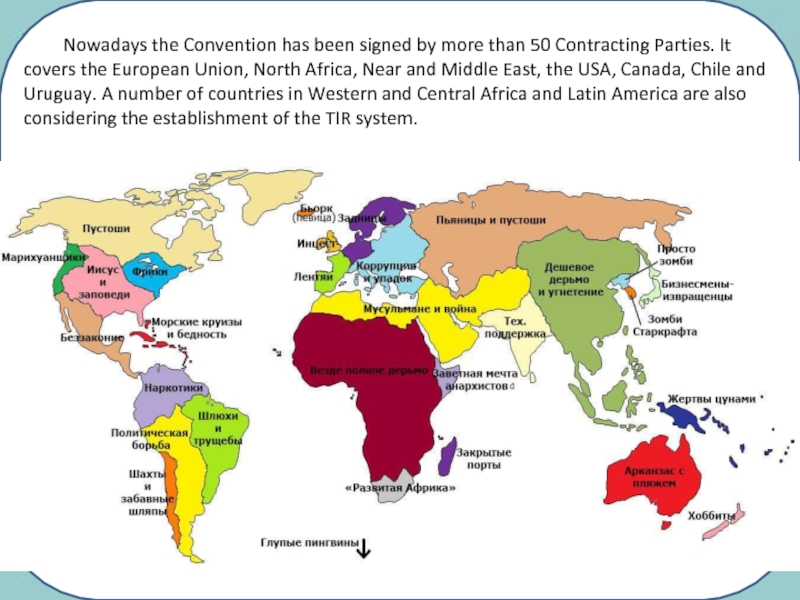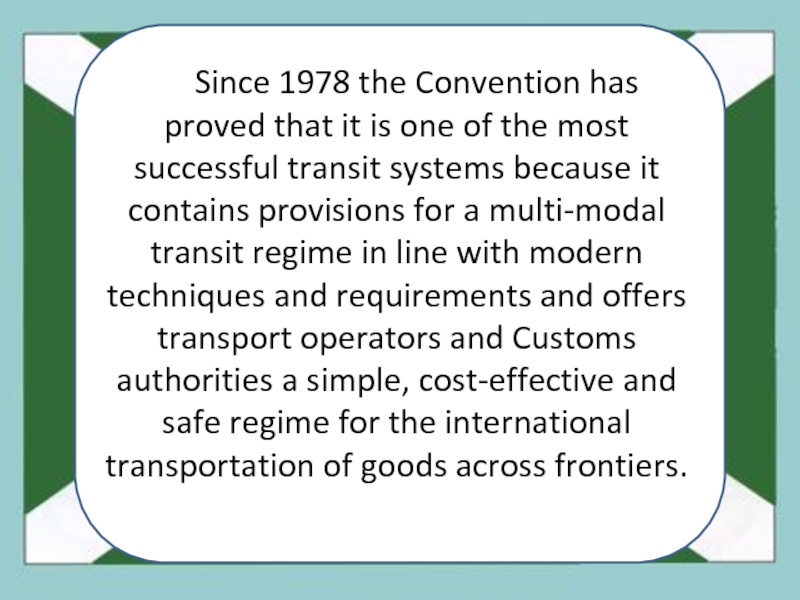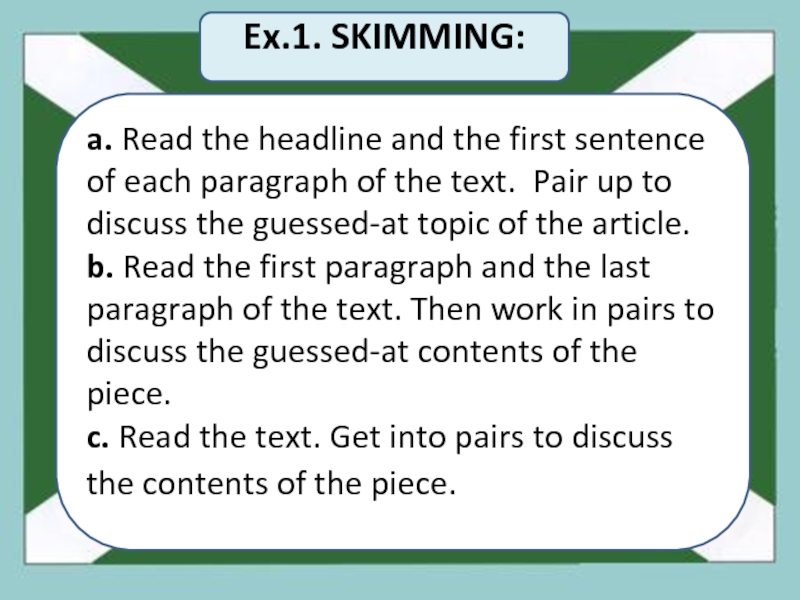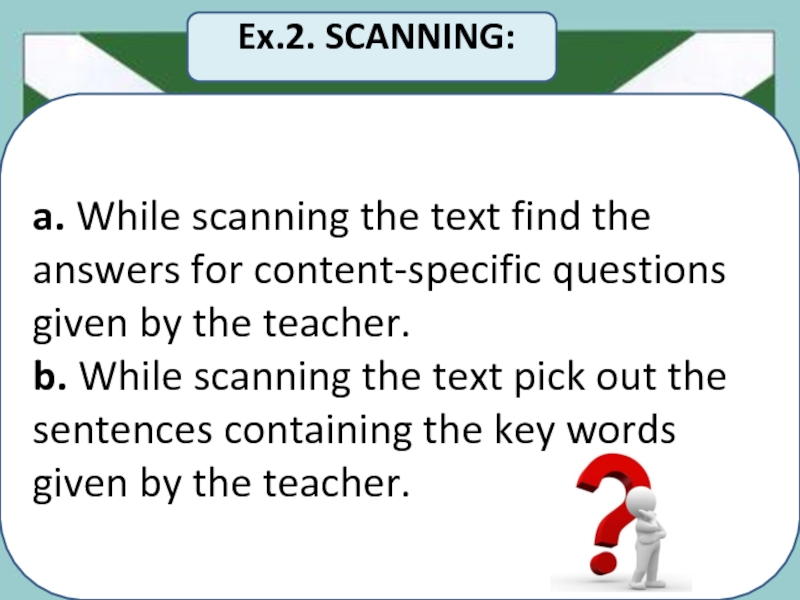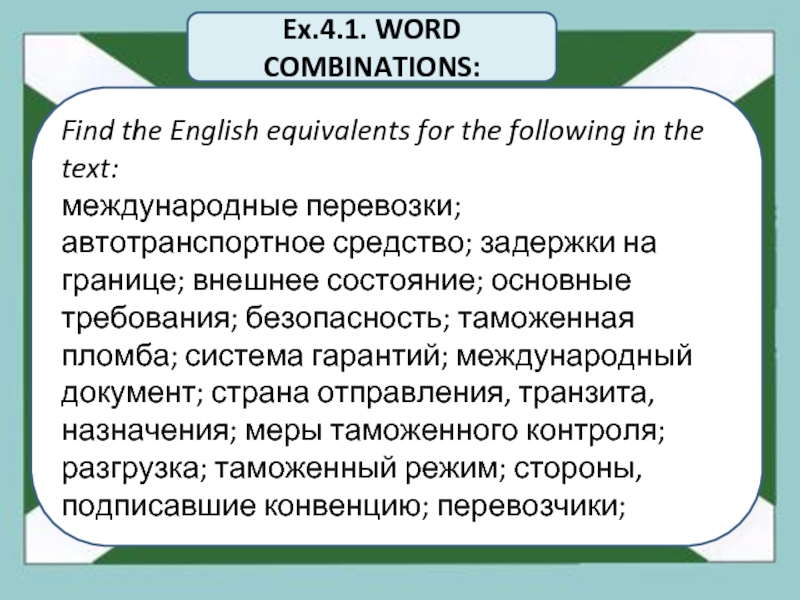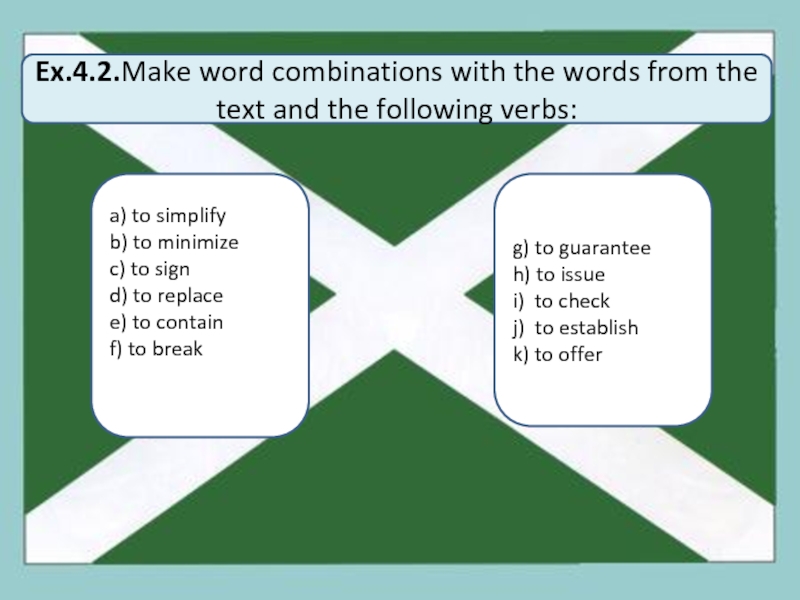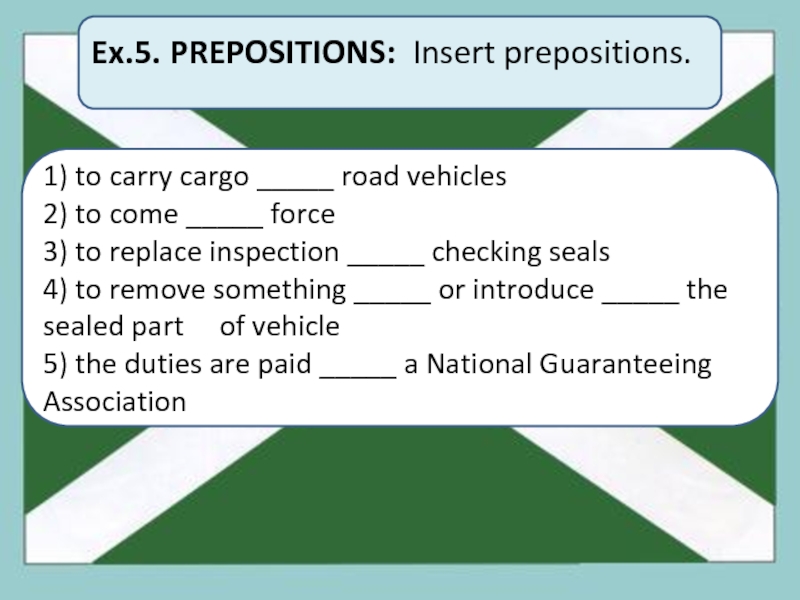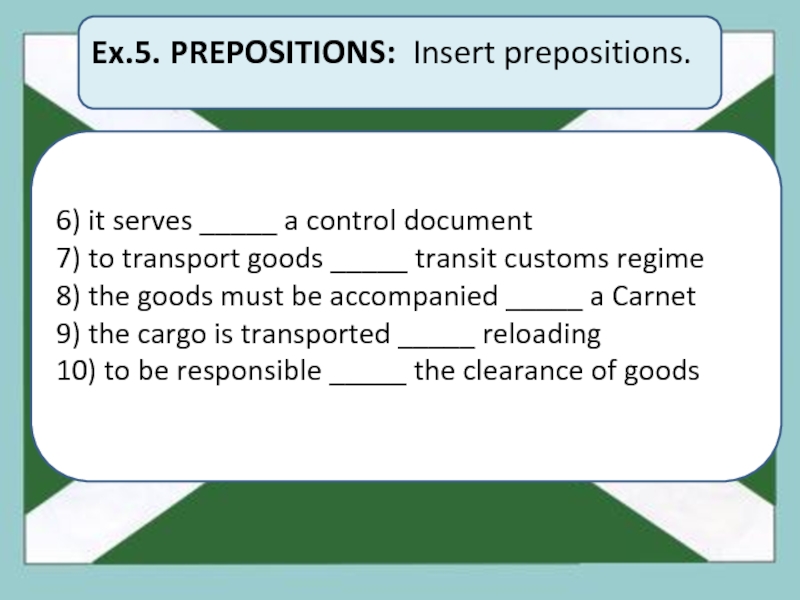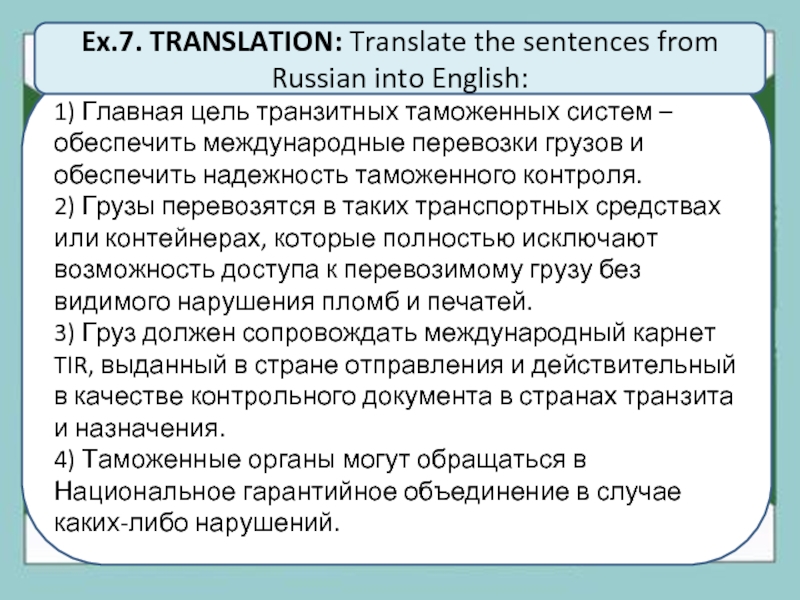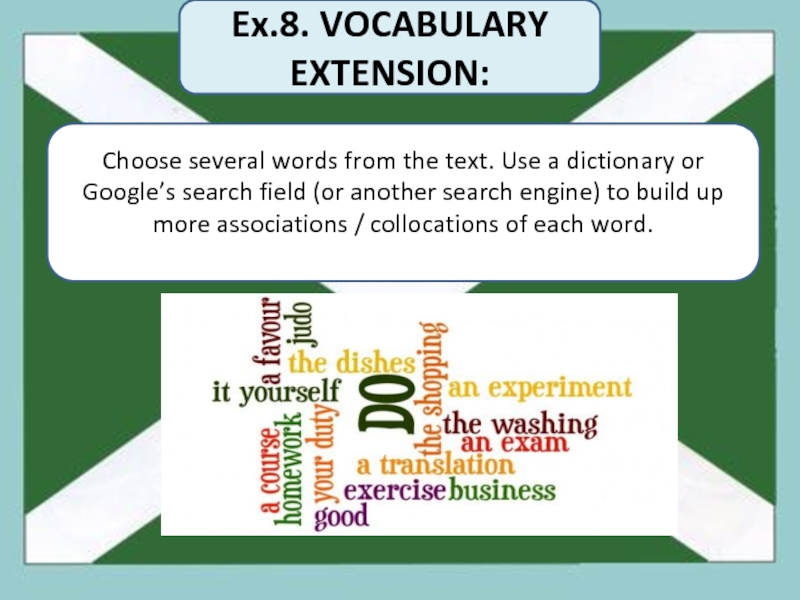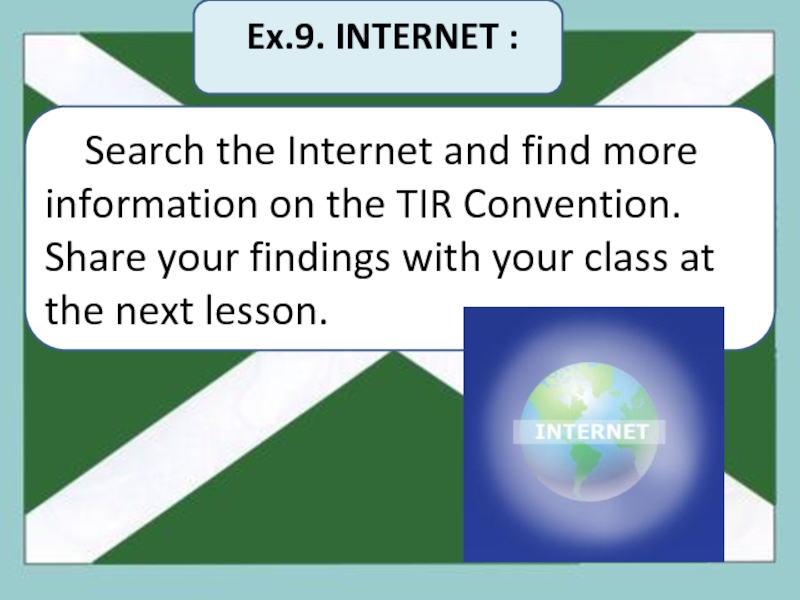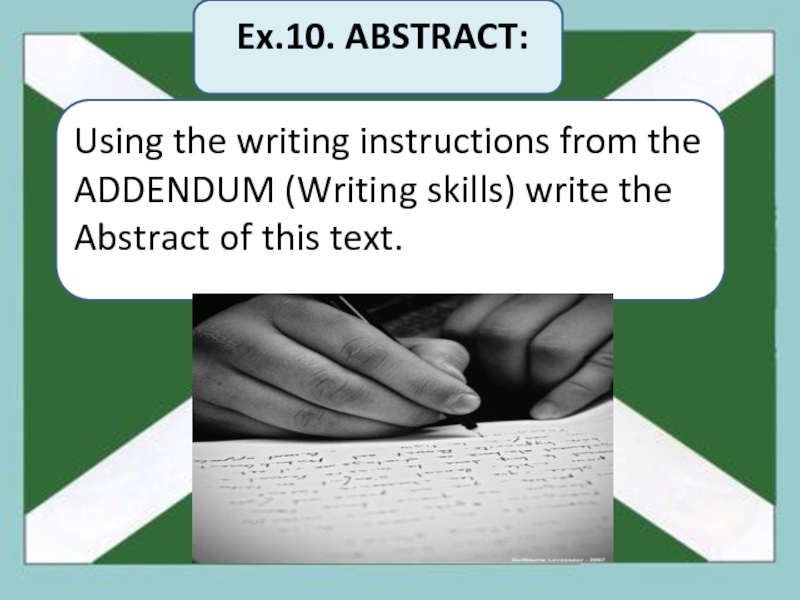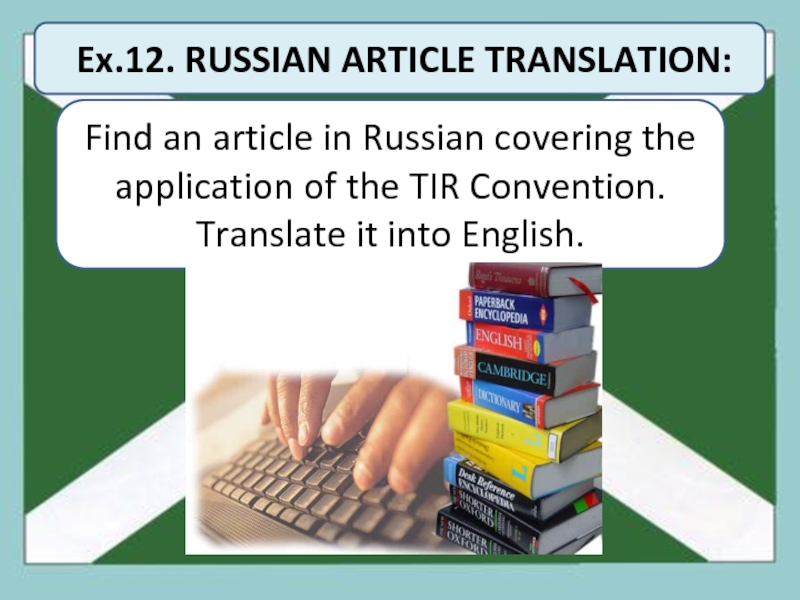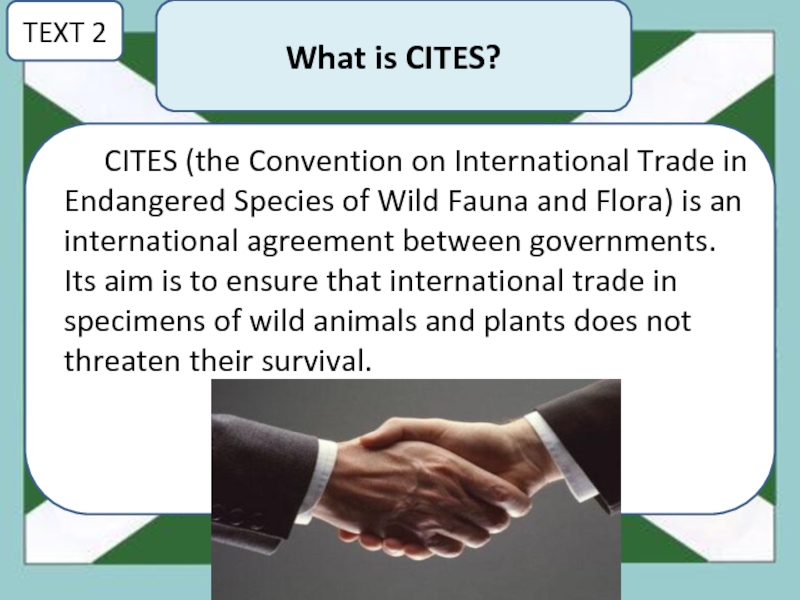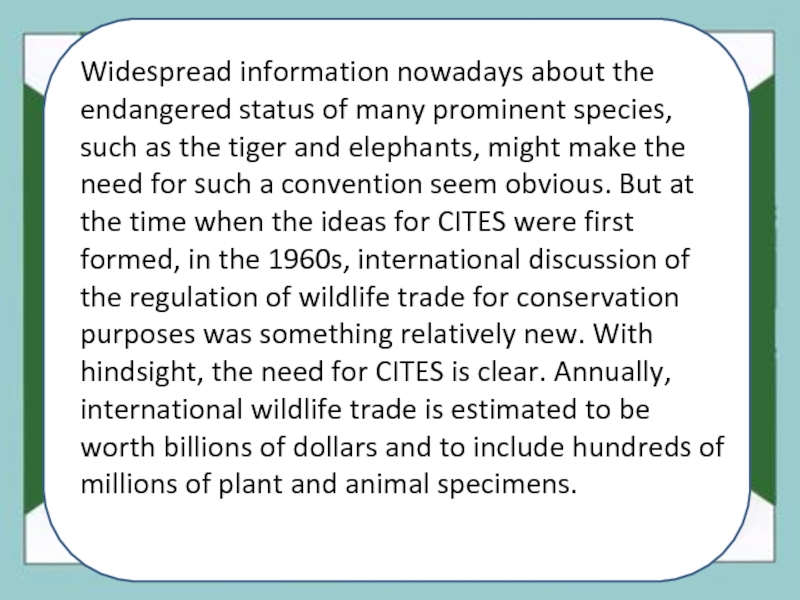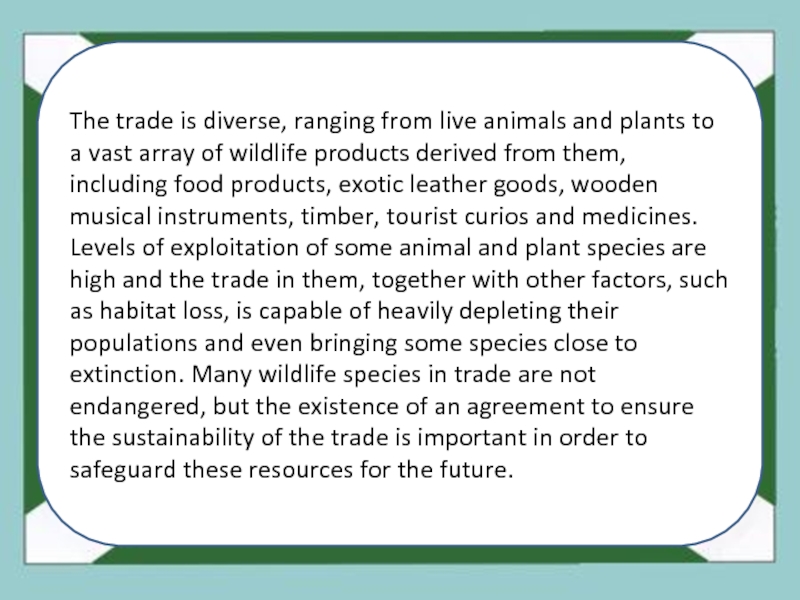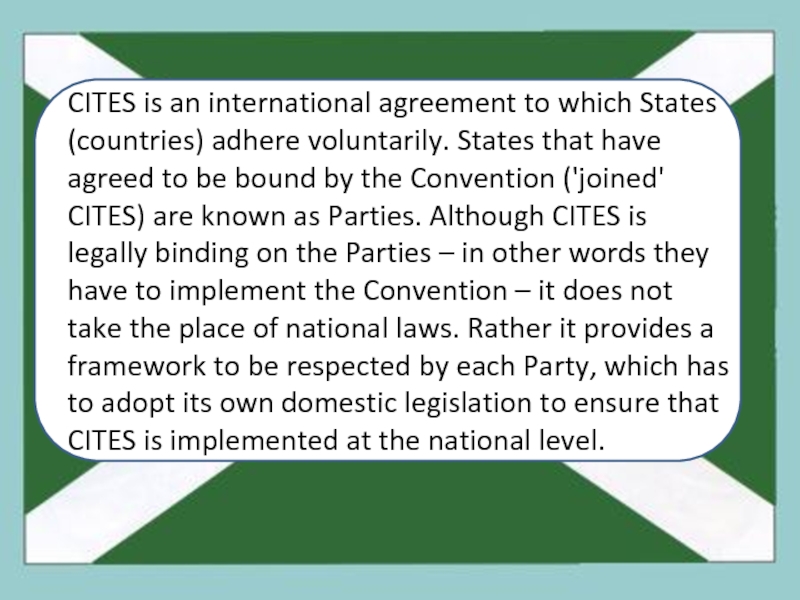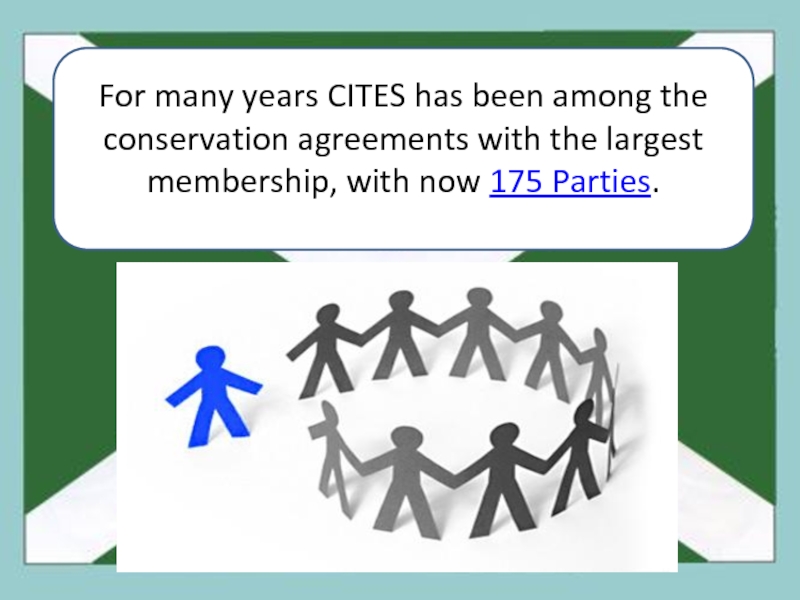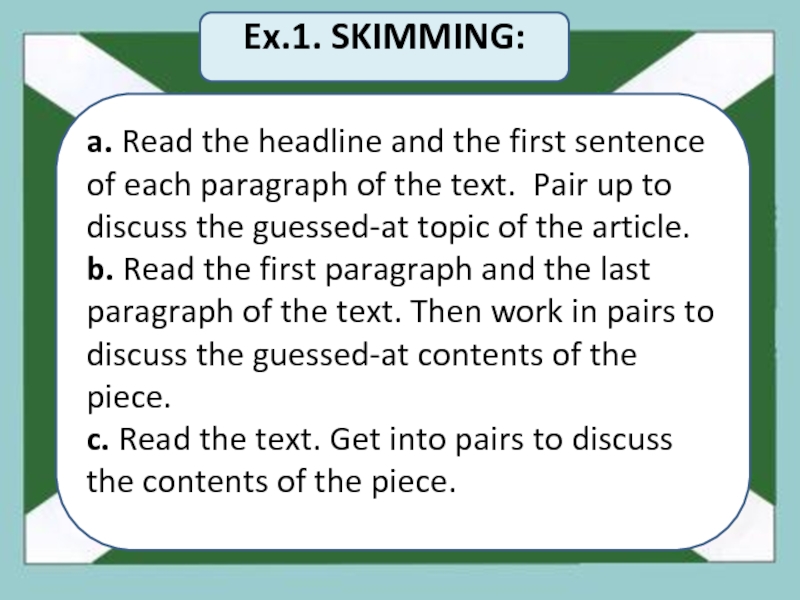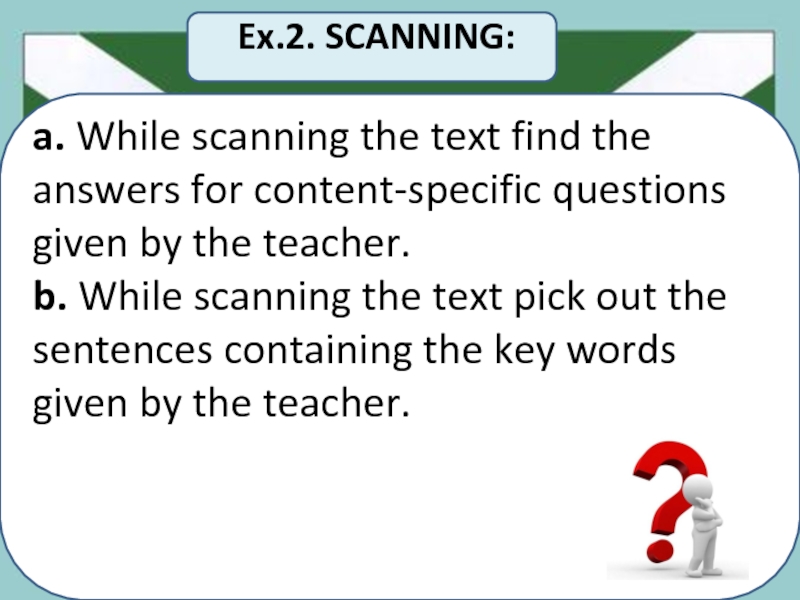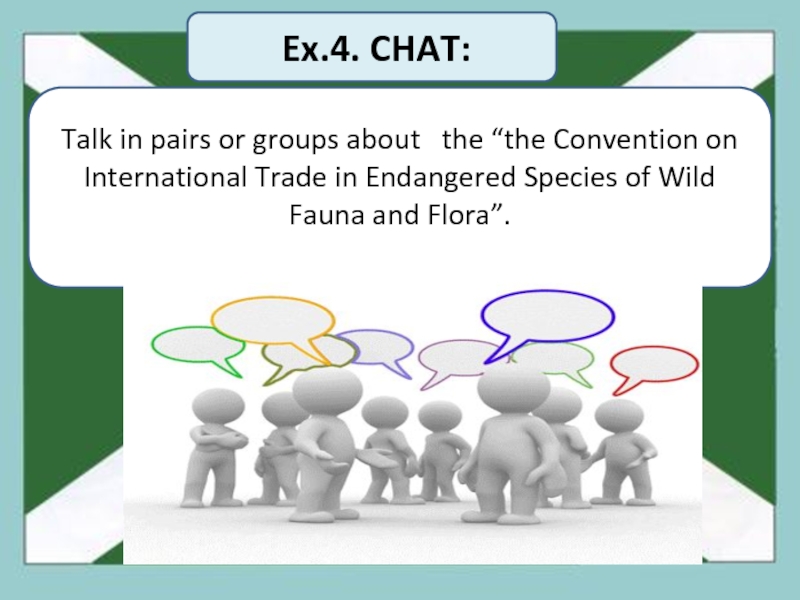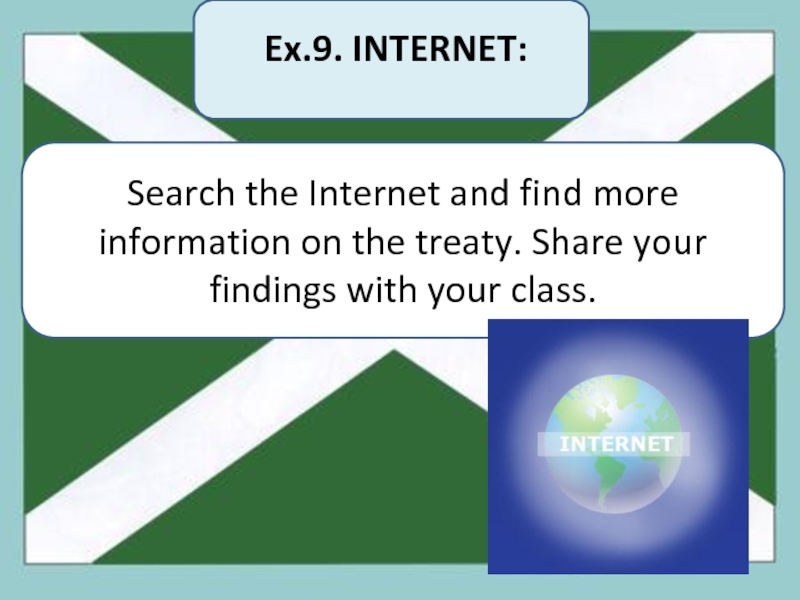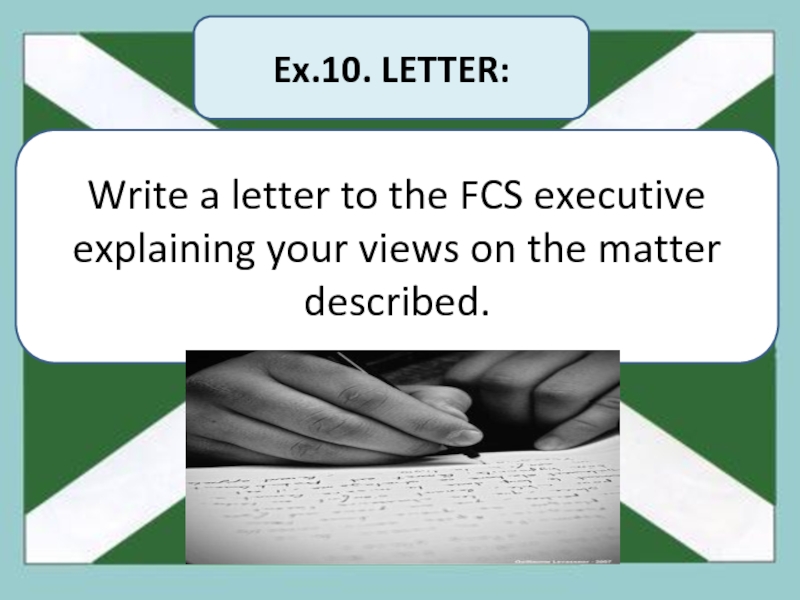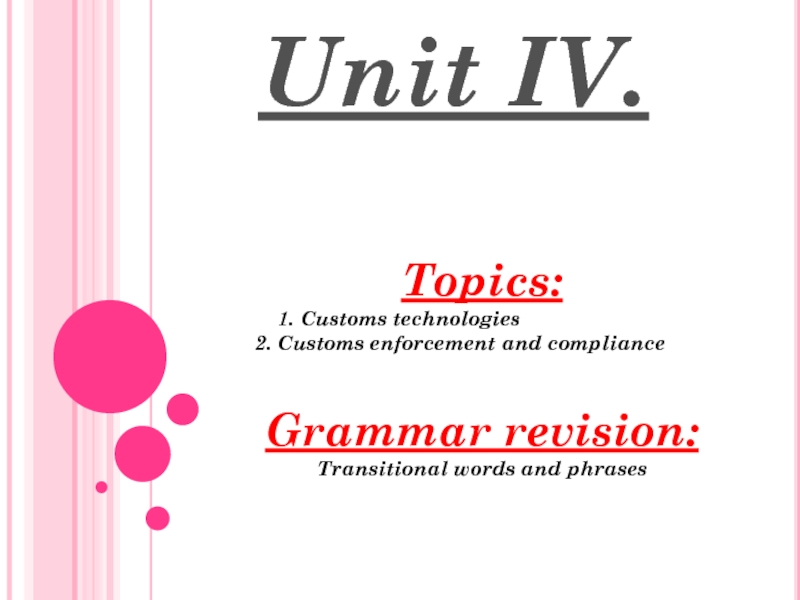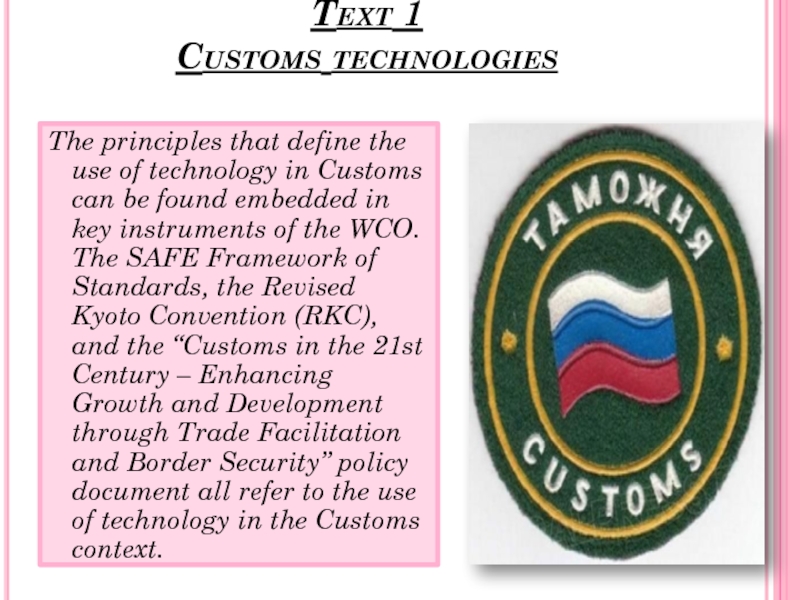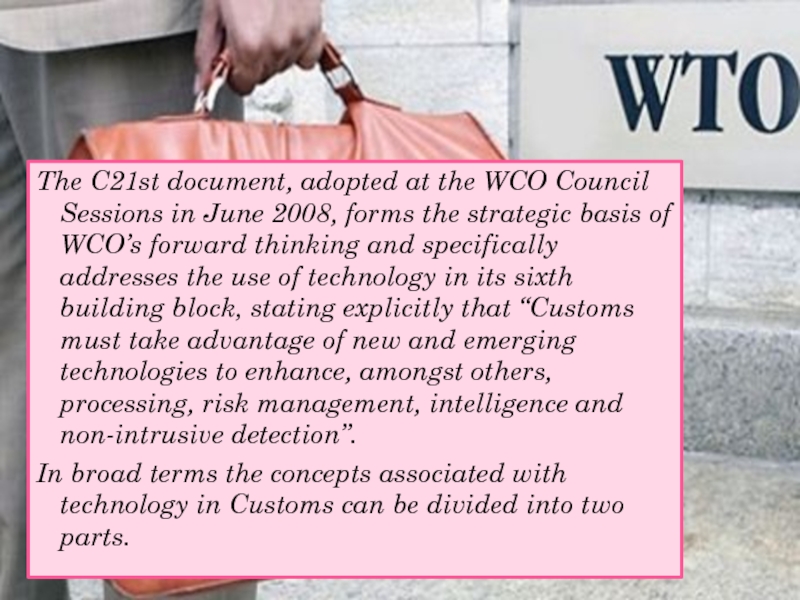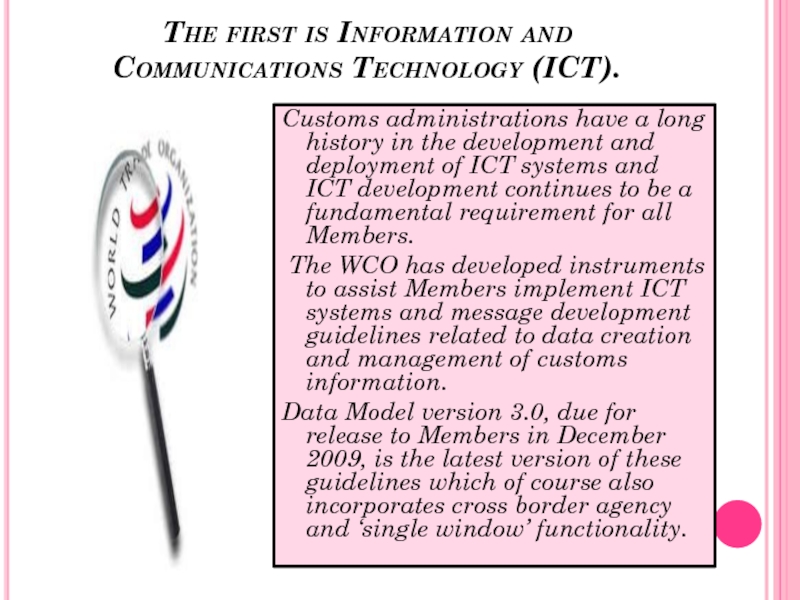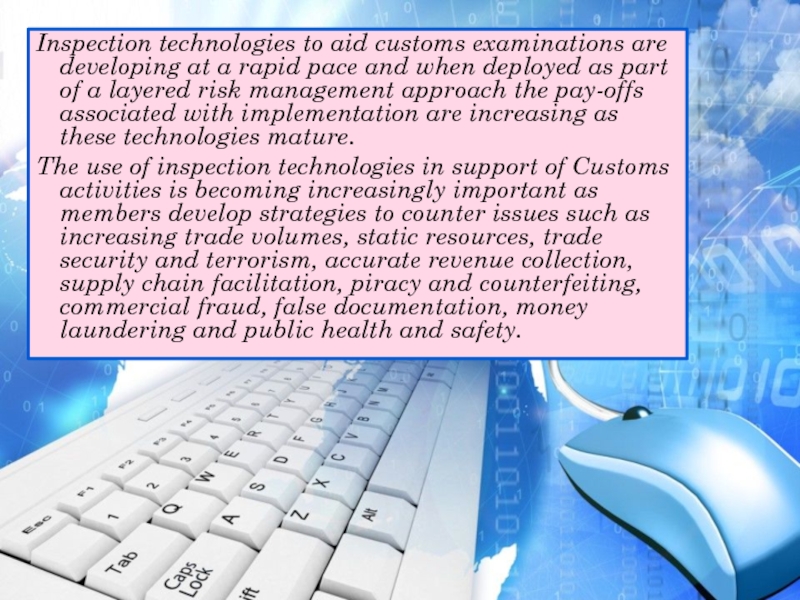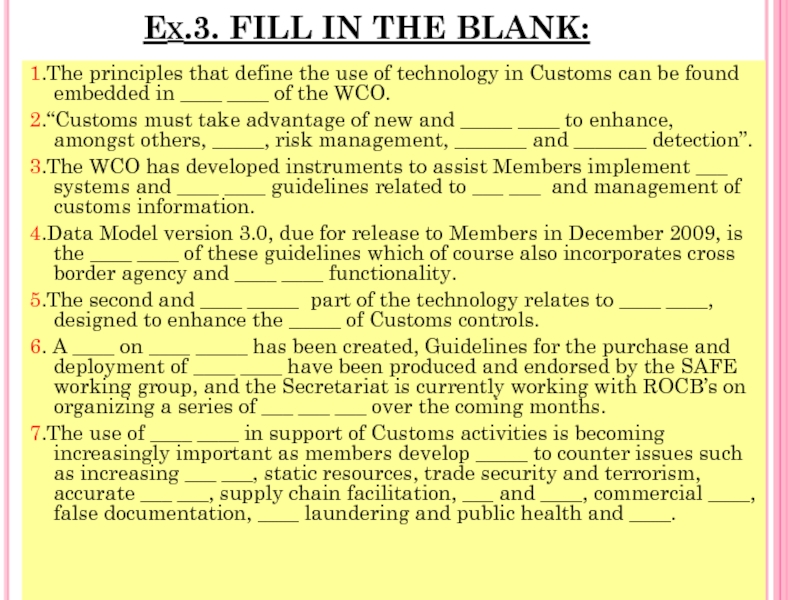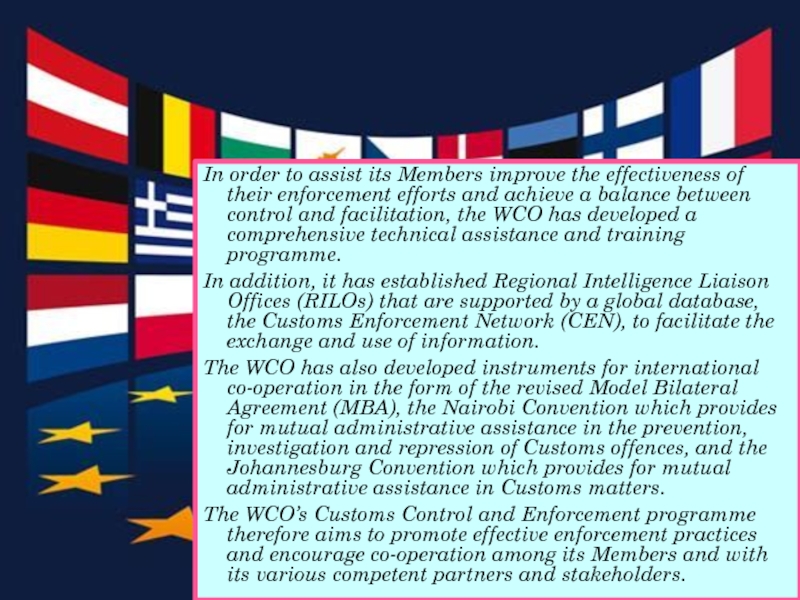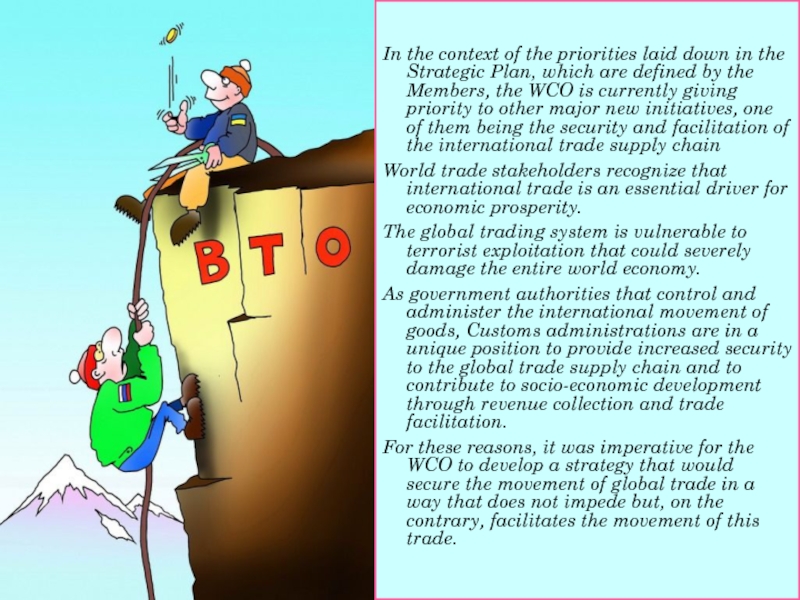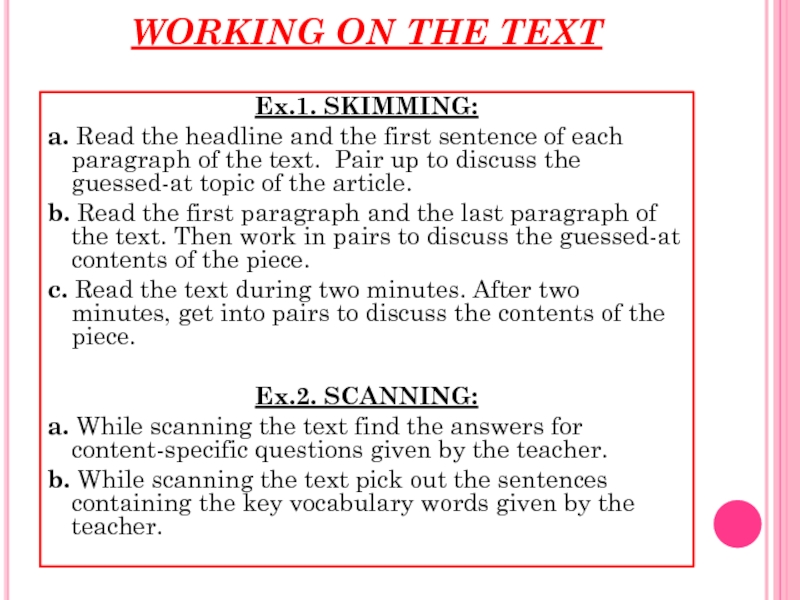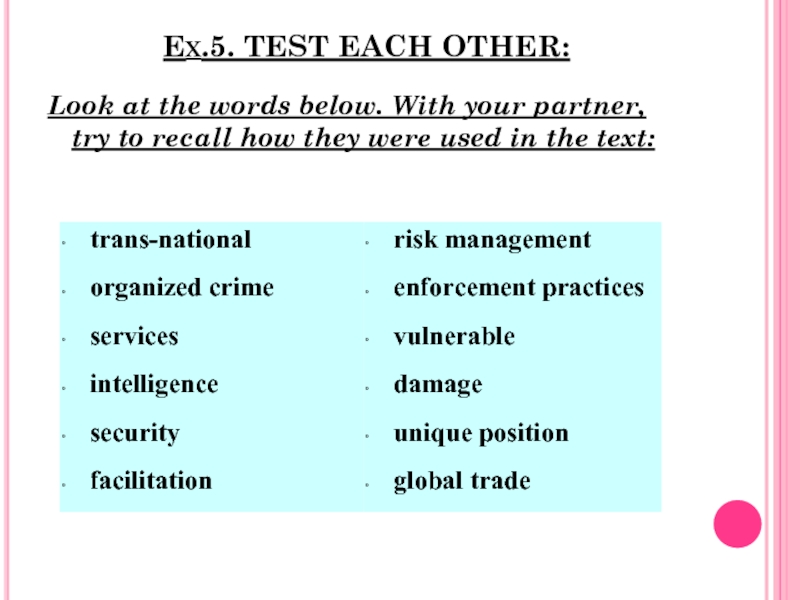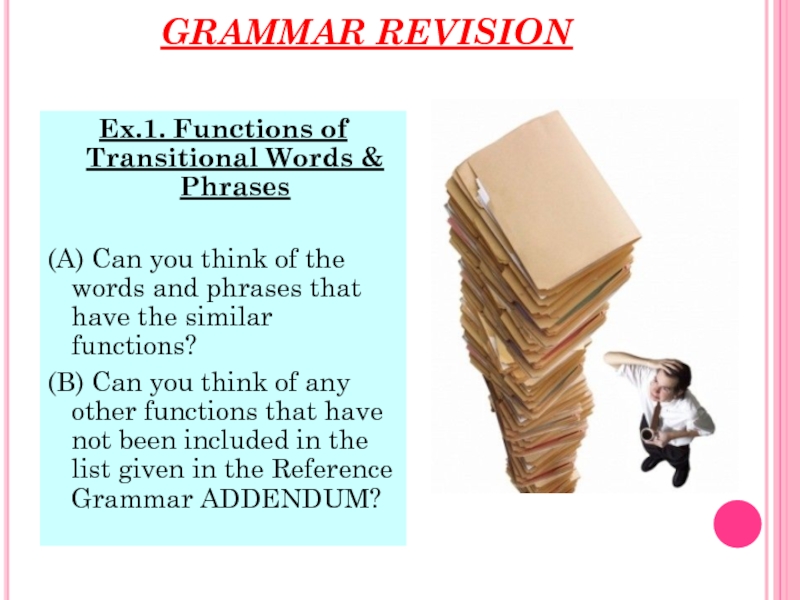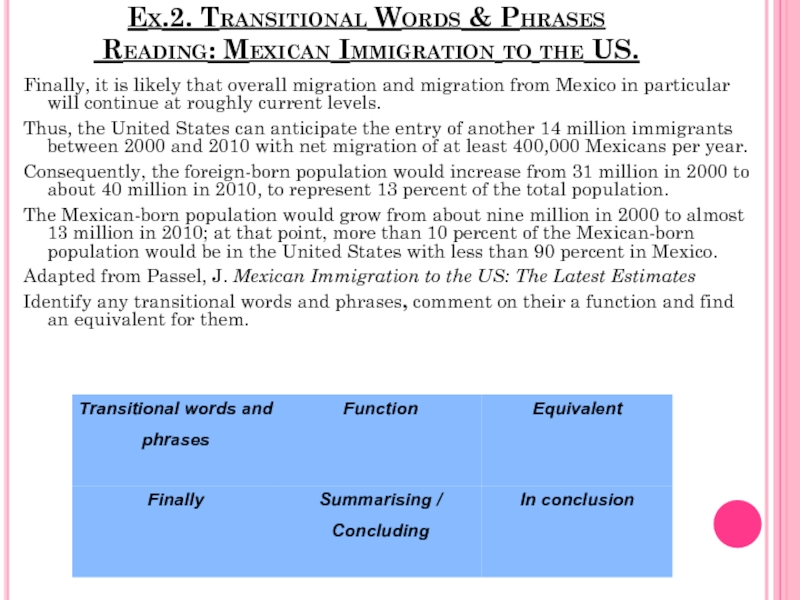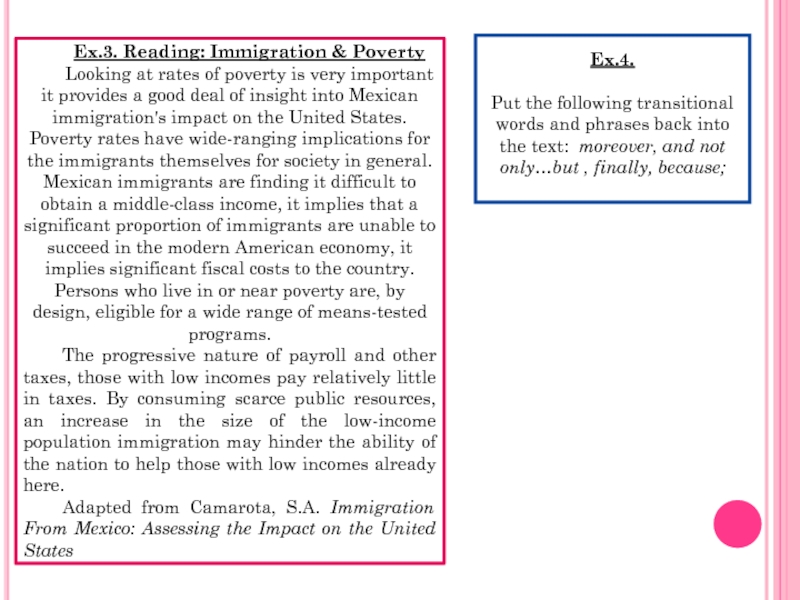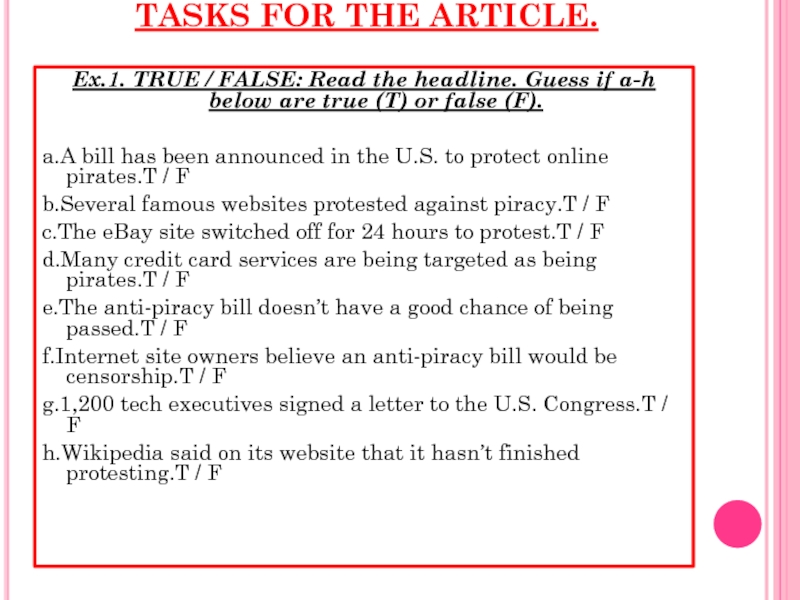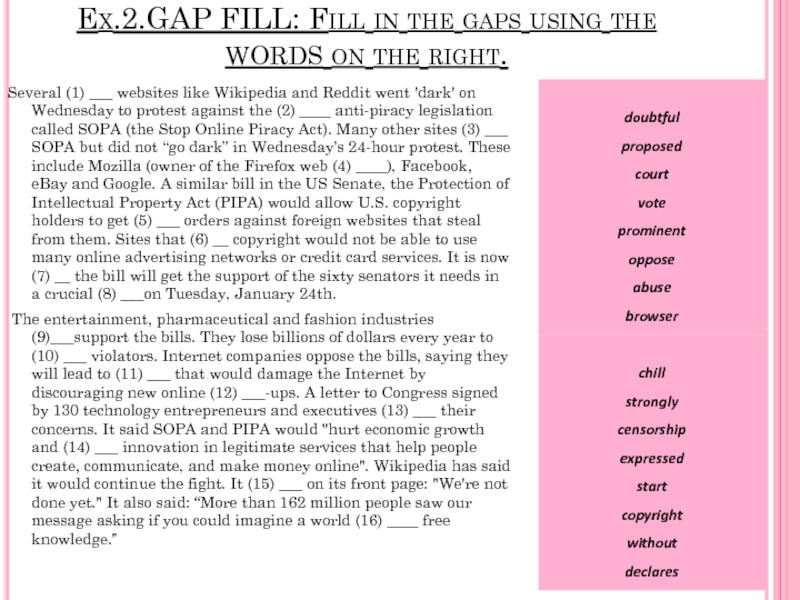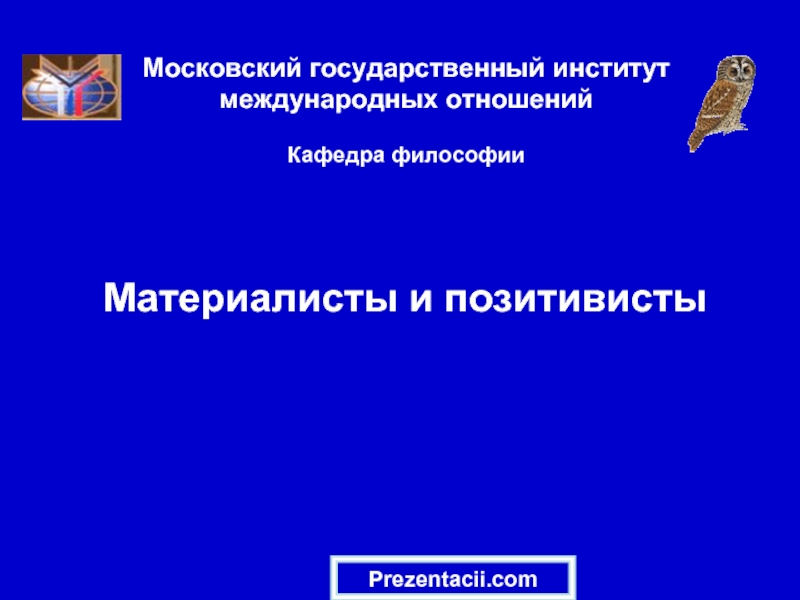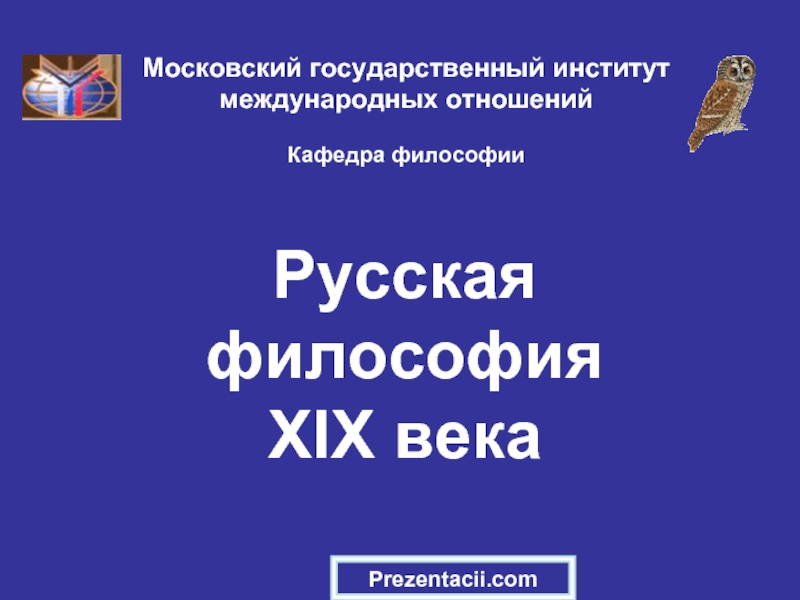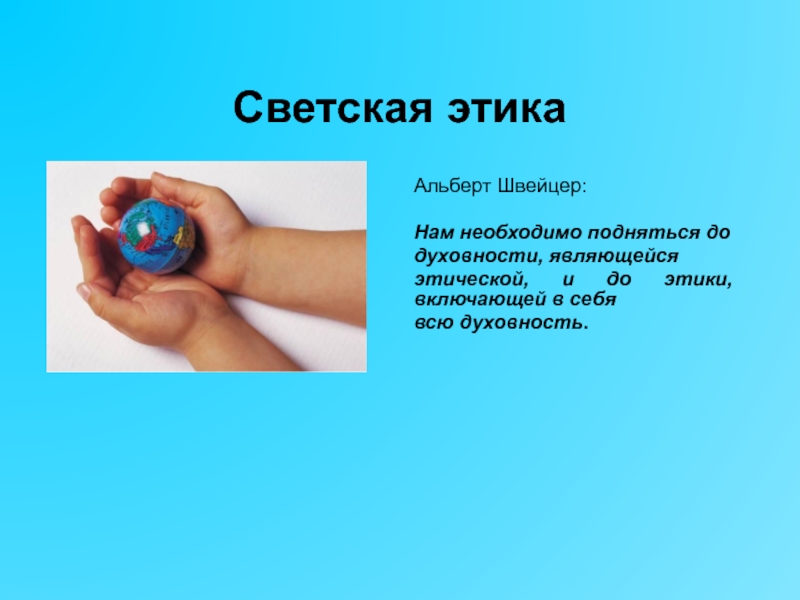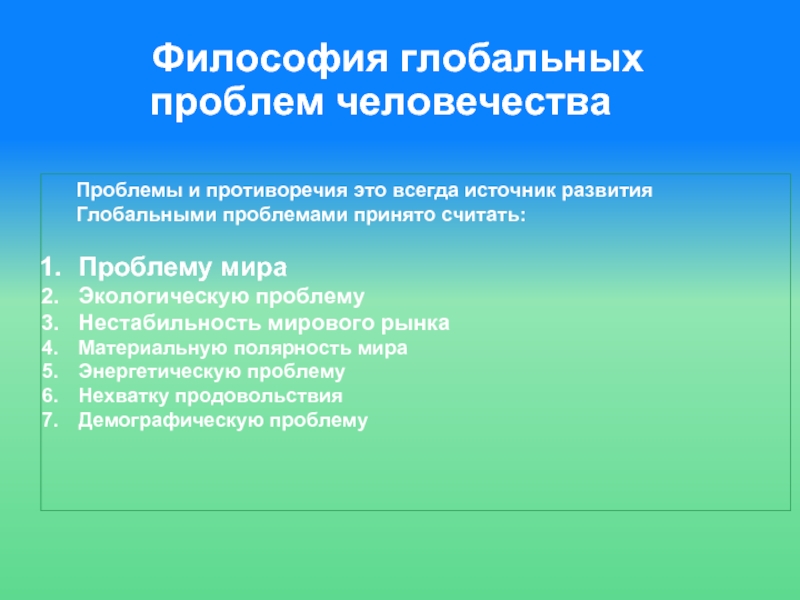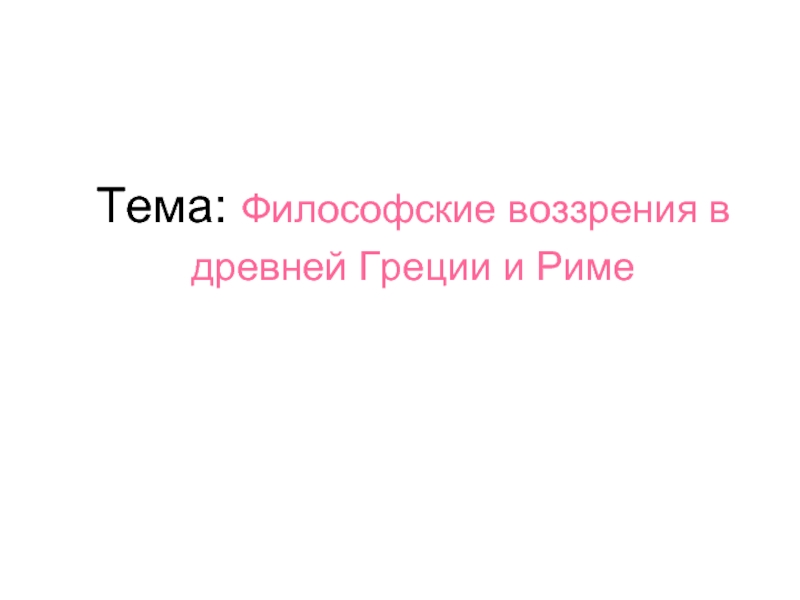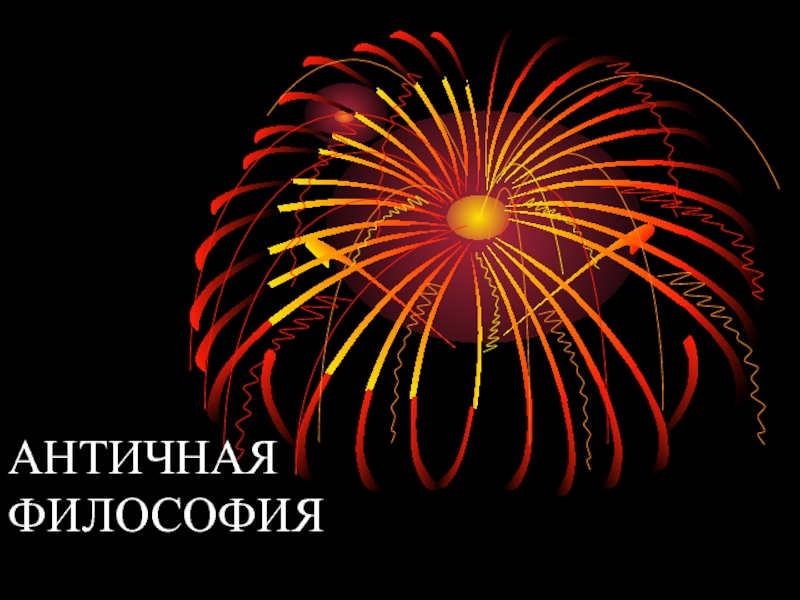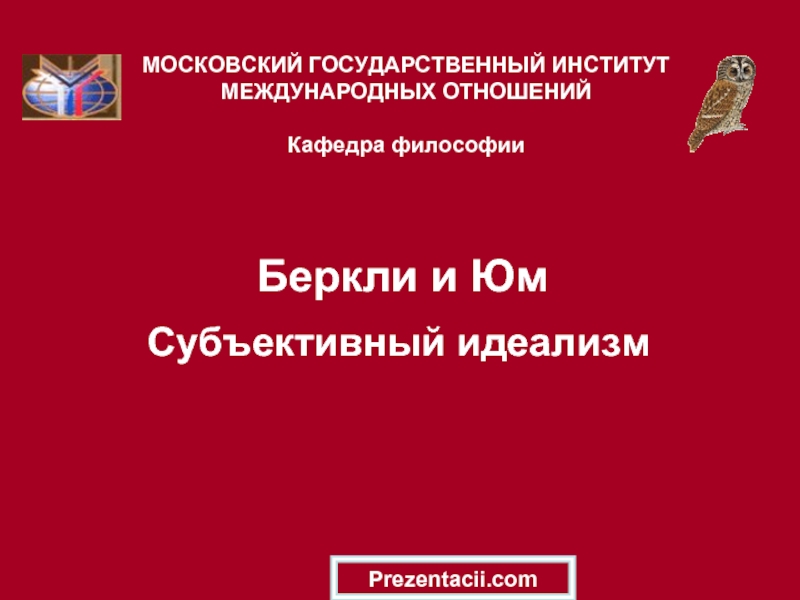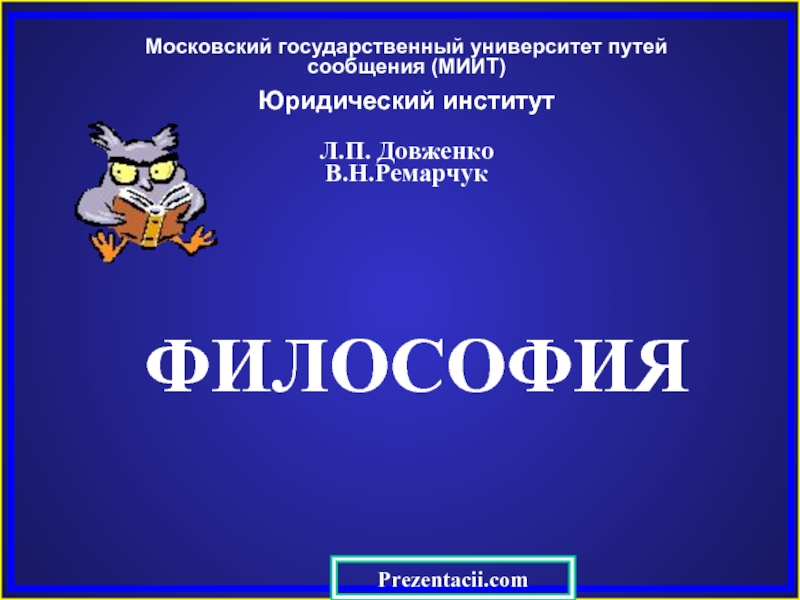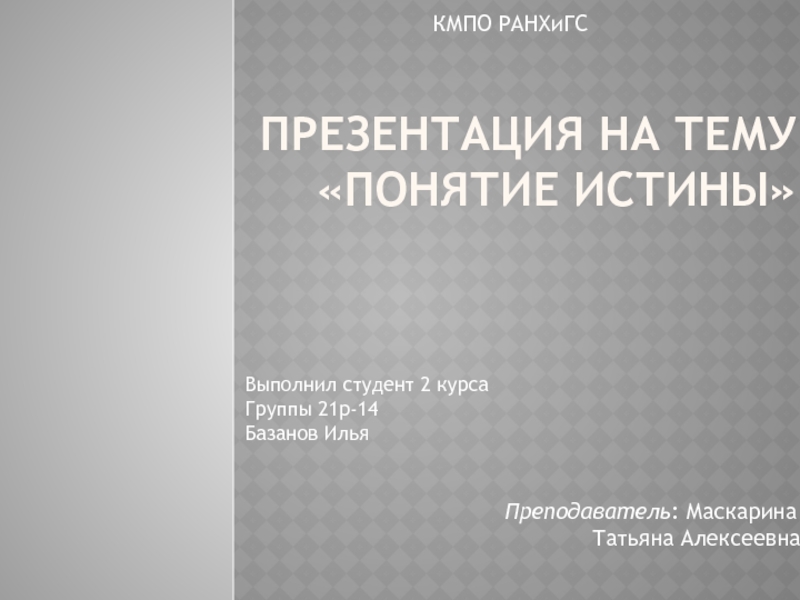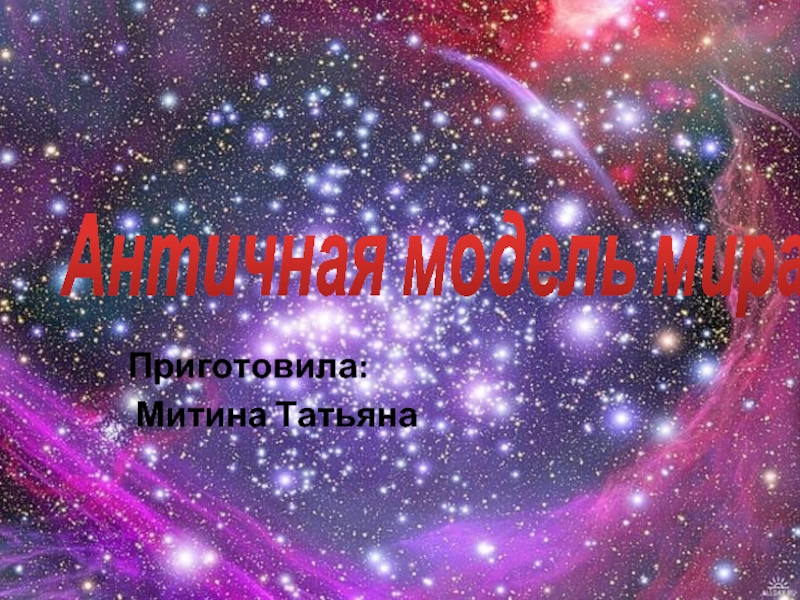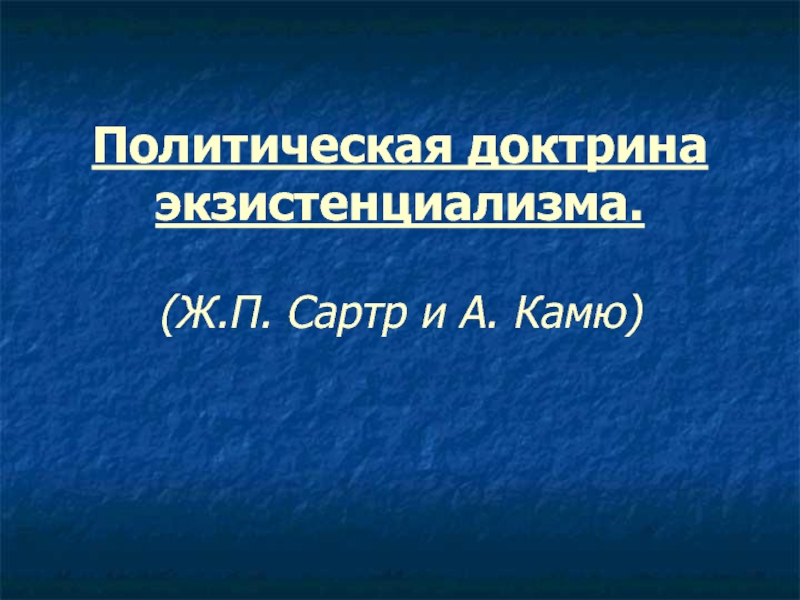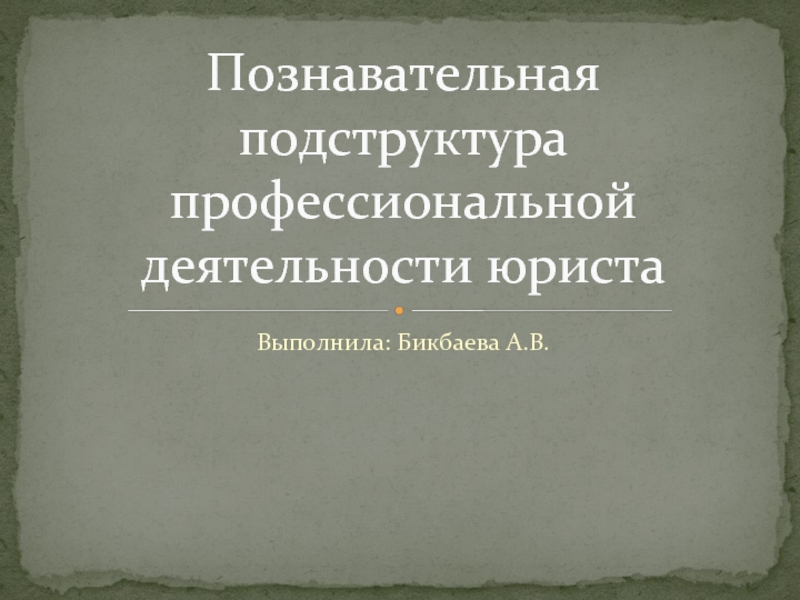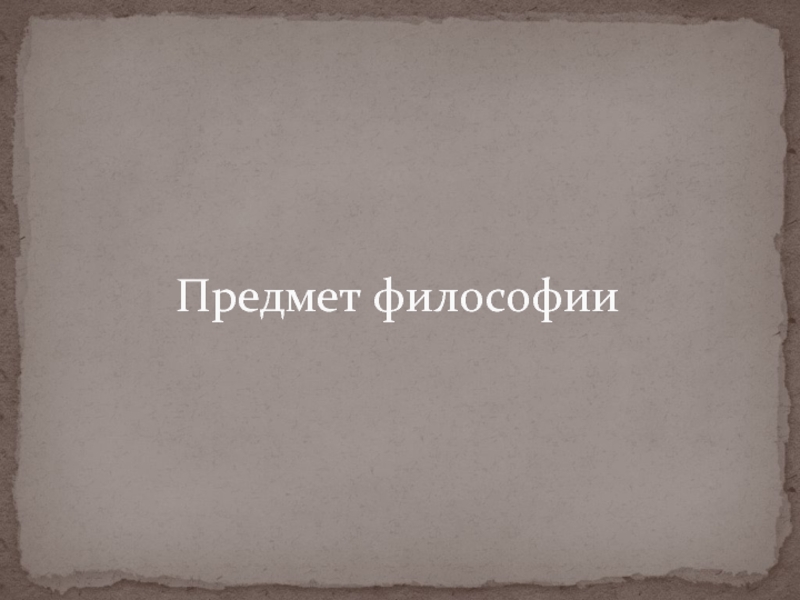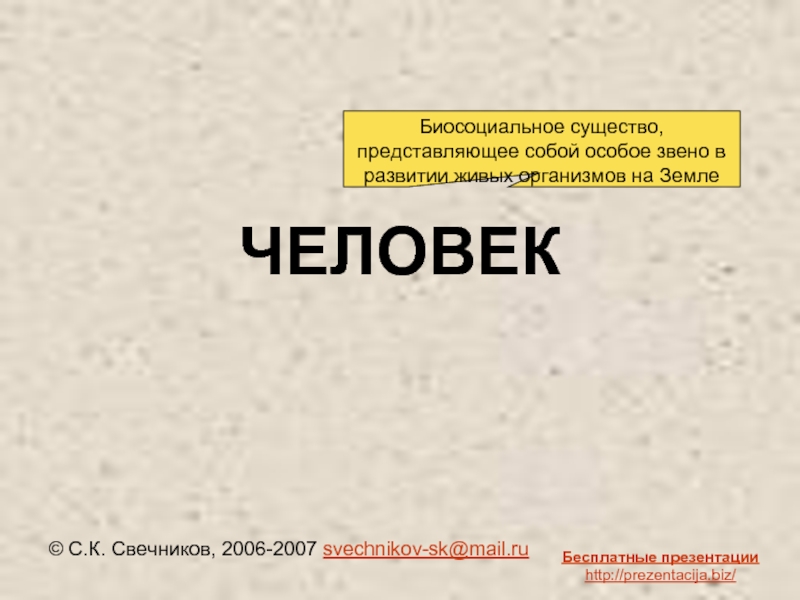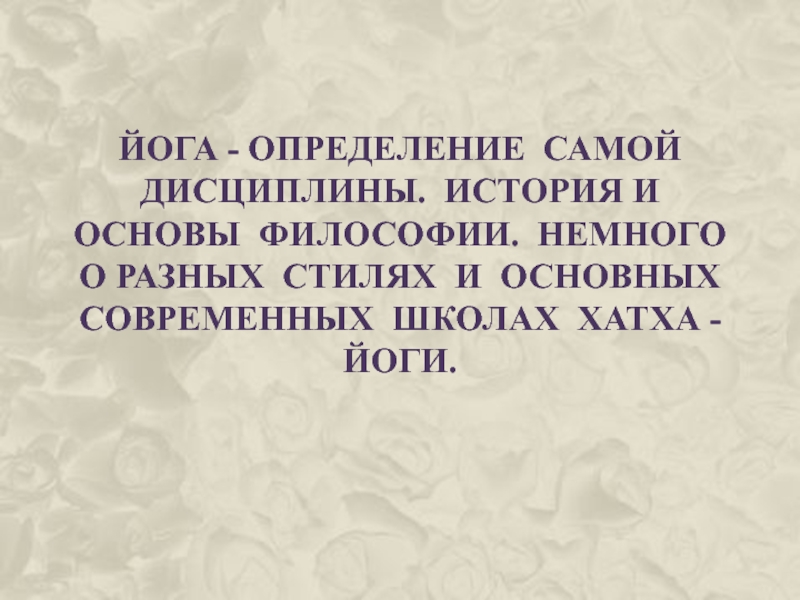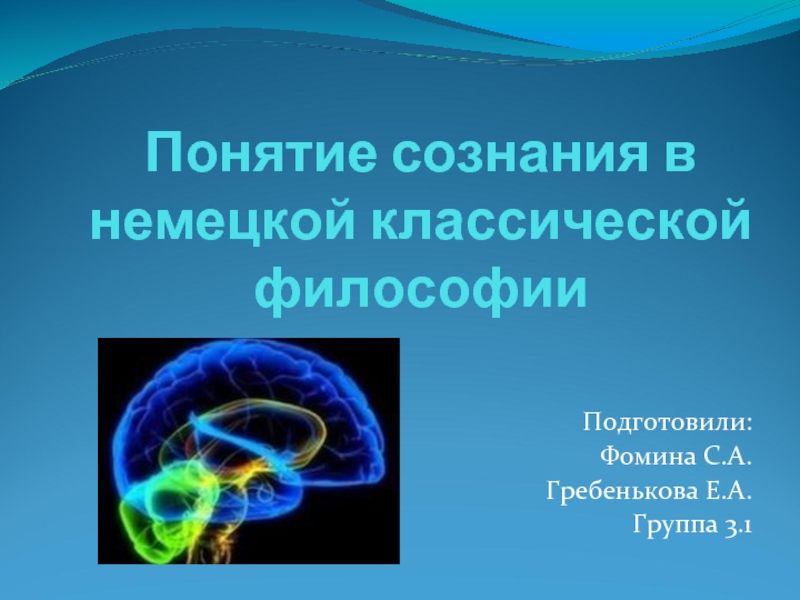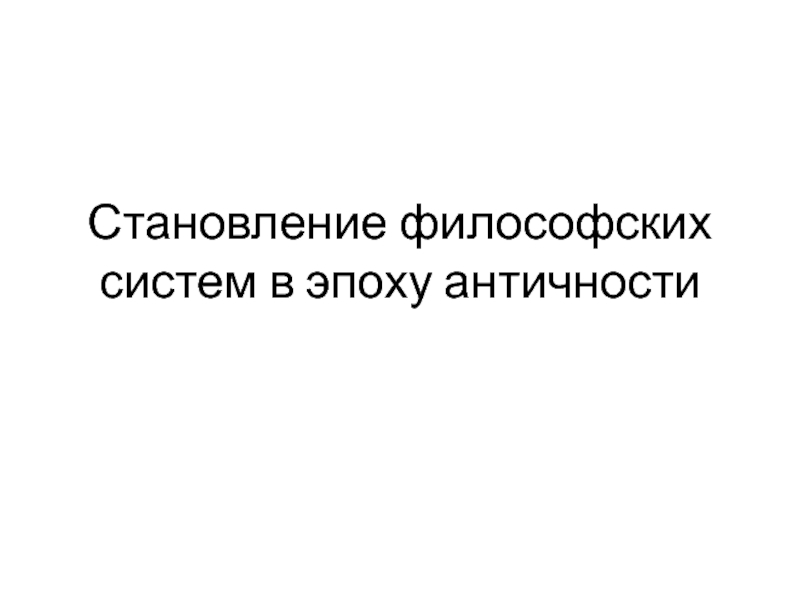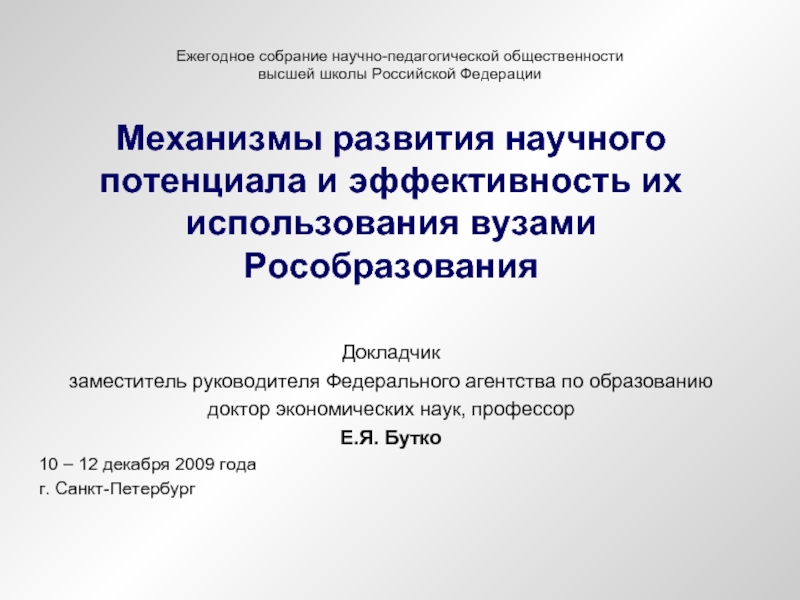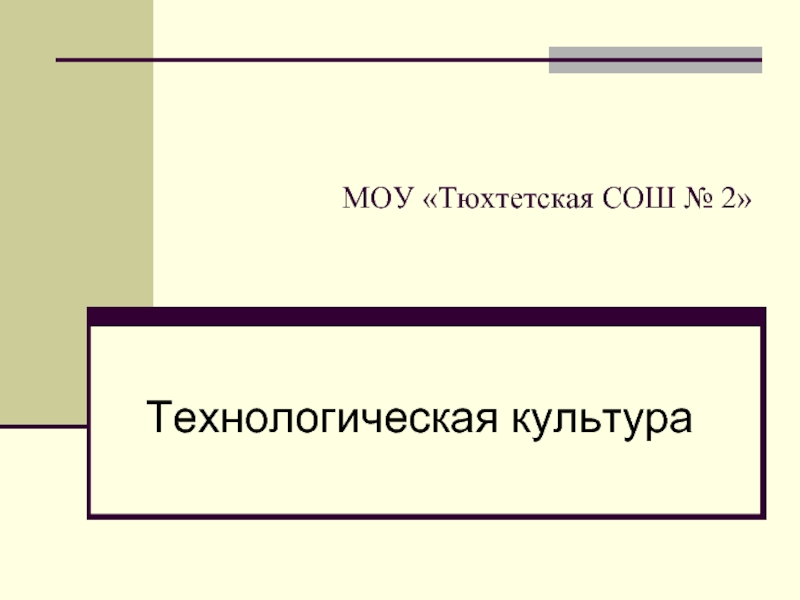Разделы презентаций
- Разное
- Английский язык
- Астрономия
- Алгебра
- Биология
- География
- Геометрия
- Детские презентации
- Информатика
- История
- Литература
- Математика
- Медицина
- Менеджмент
- Музыка
- МХК
- Немецкий язык
- ОБЖ
- Обществознание
- Окружающий мир
- Педагогика
- Русский язык
- Технология
- Физика
- Философия
- Химия
- Шаблоны, картинки для презентаций
- Экология
- Экономика
- Юриспруденция
Customs convention
Содержание
- 1. Customs convention
- 2. Customs conventions and recomendations Text 1Since the
- 3. In 1923 the League of Nations signed
- 4. In order to achieve its objectives, the
- 5. It comprises about 5000 commodity groups, each
- 6. 2) ATA Convention and the Convention on
- 7. 3) The Arusha Declaration on Customs Integrity
- 8. 4) The SAFE Framework of Standards to
- 9. WORKING ON THE TEXT
- 10. Ex.2. SCANNING: a. While scanning the text
- 11. Ex.3. READING:Read and translate the text.
- 12. a.Since the beginning of the 19-th century,
- 13. e.The Istanbul Convention is the only one
- 14. Ex.9. VOCABULARY:Circle the words you do not
- 15. The Revised Kyoto Convention Text 2The International
- 16. The WCO Council adopted the revised Kyoto
- 17. The revised Kyoto Convention elaborates several key
- 18. The revised Kyoto Convention promotes trade facilitation
- 19. WORKING ON THE TEXT
- 20. Ex.1. SKIMMING: a. Read the headline
- 21. Ex.2. SCANNING: a. While scanning the
- 22. Ex.3. READING: Read and translate the text.
- 23. Ex.6. TEXT CONTENT EXPLANATION: Explain the following
- 24. GRAMMAR REVISION
- 25. Ex.1.Grammar Tenses Mix Fill the gaps with
- 26. The atmosphere at the Dungeon (be) _______
- 27. Well, if you (fancy) _______that kind of
- 28. Besides the regular opening hours, the Dungeon
- 29. WORKING ON THE ARTICLE
- 30. Kyoto Protocol heated bra developed The lingerie
- 31. Triumph recently unveiled the bra in Japan
- 32. It has an attached scarf that is
- 33. TASKS FOR THE ARTICLE
- 34. Ex.1. Problems for discussion: A)UNDERWEAR: In
- 35. B) ECO-FASHION: What do you think
- 36. Ex.2. TRUE / FALSE:a. A bra that
- 37. e. The maker hopes the bras will
- 38. Ex.3. SYNONYM MATCH: Match the following synonyms from the article: a.lingerieb.reducec.extrad.unveilede.amountf.preventg.provideh.meanti.rangej.producevolumevarietyaddmorestopcutshownmakeunderwearsupposed
- 39. Ex.8. TEXT QUESTIONS:Look back at the text
- 40. ADDITIONAL TASKS
- 41. 1. VOCABULARY EXTENSION:Choose several of the words
- 42. 2. INTERNET:Search the Internet and find more
- 43. 3. KYOTO PROTOCOL LIFE:Make a poster describing
- 44. Unit IITopics:1. The HS Convention2. The Istanbul ConventionGrammar revision: English verb tenses
- 45. Text 1: The HS Convention `The International Convention
- 46. The Nomenclature governed by the Convention on
- 47. The HS Nomenclature comprises about 5,000 commodity
- 48. The HS Convention provides for two types
- 49. Generally, the amendments to the HS Convention
- 50. WORKING ON THE TEXTEx.1. SKIMMINGa. Read the
- 51. Ex.6. 2-MINUTE DEBATES: Students face each other
- 52. Ex.11. TRUE / FALSE: Look through the
- 53. Text 2: The Istanbul Convention Convention
- 54. It is aimed at simplifying and harmonizing
- 55. With this system the international business community
- 56. WORKING ON THE TEXTEx.1. SKIMMING: a. Read
- 57. Ex.6. 2-MINUTE DEBATES: Students face each other
- 58. Ex.11. TRUE / FALSE: Look through the
- 59. GRAMMAR REVISIONEx.1. Grammar Tenses Mix Fill the
- 60. 9. Now I (have) _____ much
- 61. WORKING ON THE ARTICLE: Anti-tobacco treaty begins
- 62. The WHO's coordinator of the Framework Convention
- 63. TASKS FOR THE ARTICLEEx.1. CHAT: Talk in
- 64. Ex.4. 'FILTHY' HABIT: Talk about other ‘filthy’/bad/unsociable
- 65. Ex.7. TRUE / FALSE: Look at the
- 66. Ex.9. PHRASE MATCH: Match the following phrases
- 67. The TIR CONVENTION International carriage of cargo by
- 68. TIR is the abbreviation for Customs Convention
- 69. When the cargo arrives at the Customs
- 70. Nowadays the Convention has been signed by
- 71. Since 1978 the Convention has proved that
- 72. WORKING ON THE TEXT
- 73. Ex.1. SKIMMING: a. Read the headline and
- 74. Ex.2. SCANNING: a. While scanning the
- 75. Ex.3.READING: Read and translate the text “The TIR Convention”.
- 76. Ex.4.1. WORD COMBINATIONS:Find the English equivalents for
- 77. Ex.4.2.Make word combinations with the words from
- 78. Ex.5. PREPOSITIONS: Insert prepositions.1) to carry cargo
- 79. 6) it serves _____ a control document
- 80. Ex.6. QUESTIONS: Answer the questions:1) What
- 81. 1) Главная цель транзитных таможенных систем –
- 82. 5) Меры таможенного контроля, предпринятые в стране
- 83. Choose several words from the text. Use
- 84. Ex.9. INTERNET : Search the Internet
- 85. Ex.10. ABSTRACT:Using the writing instructions from
- 86. Ex.11. SPEAKING: Speak on the topic “The TIR Convention”
- 87. Ex.12. RUSSIAN ARTICLE TRANSLATION:Find an article
- 88. CITES (the Convention on International Trade in
- 89. Widespread information nowadays about the endangered status
- 90. The trade is diverse, ranging from live
- 91. Because the trade in wild animals and
- 92. CITES was drafted as a result of
- 93. CITES is an international agreement to which
- 94. For many years CITES has been among
- 95. WORKING ON THE TEXT
- 96. Ex.1. SKIMMING: a. Read the headline and
- 97. Ex.2. SCANNING: a. While scanning the
- 98. Ex.3.READING: Read and translate the text “What is CITES?”
- 99. Ex.4. CHAT:Talk in pairs or groups
- 100. Ex.5. CITES BRAINSTORM:Spend one minute writing down
- 101. Ex.6. 2-MINUTE DEBATES:Students face each other
- 102. Ex.7. VOCABULARY EXTENSION: Choose several words from the
- 103. Ex.8. TRUE / FALSE: Look through
- 104. Ex.8. TRUE / FALSE: Look through
- 105. Ex.9. INTERNET:Search the Internet and find
- 106. Ex.10. LETTER:Write a letter to the FCS executive explaining your views on the matter described.
- 107. Ex.11. PUBLIC POLICY:You are the leader
- 108. Ex.12. RENDERING:Render the text.
- 109. GRAMMAR REVISION
- 110. Ex.1. Grammar Tenses MixIn the year
- 111. Ex.1. Grammar Tenses Mix6. The Wall
- 112. Ex.1. Grammar Tenses Mix11. Between the
- 113. Unit IV. Topics: 1. Customs technologies 2. Customs enforcement and complianceGrammar revision: Transitional words and phrases
- 114. Text 1 Customs technologies
- 115. The C21st document, adopted at the WCO
- 116. The first is Information and Communications Technology
- 117. In addition to the work done within
- 118. The second and rapidly emerging part of
- 119. Inspection technologies to aid customs examinations are
- 120. Given the tremendous importance and opportunities now
- 121. WORKING ON THE TEXT Ex.1. SKIMMING: a.
- 122. Ex.3. FILL IN THE BLANK: 1.The principles
- 123. Text 2 What is Customs Enforcement and
- 124. In order to assist its Members improve
- 125. In the context of the priorities laid
- 126. WORKING ON THE TEXT Ex.1. SKIMMING: a.
- 127. Ex.5. TEST EACH OTHER:Look at the words
- 128. GRAMMAR REVISION Ex.1. Functions of Transitional Words
- 129. Ex.2. Transitional
- 130. Ex.3. Reading: Immigration & PovertyLooking at rates
- 131. TASKS FOR THE ARTICLE. Ex.1. TRUE /
- 132. Ex.2.GAP FILL: Fill in the gaps using
- 133. Скачать презентанцию
Слайды и текст этой презентации
Слайд 2Customs conventions and recomendations
Text 1
Since the beginning of the 20-th
century, there has been a continuous effort to standardize and
harmonize сustoms formalities with the aim of simplifying and facilitating international trade.Слайд 3In 1923 the League of Nations signed in Geneva the
International Convention relating to the Simplification of Customs Formalities. In
1947 the General Agreement on Tariffs and Trade was signed. In 1950 the Convention establishing Customs Cooperation Council was signed. This Council is still the only intergovernmental organization competent on Customs matters. Numerous studies carried out by the Council on the principal Customs procedures such as importation, exportation, duty-free admission, inward and outward processing, transit, warehousing, temporary admission etc., resulted in a series and recommendations designed to solve specific Customs problems.
Слайд 4In order to achieve its objectives, the WCO has adopted
a number of customs instruments, including but not limited to
the following:Слайд 5It comprises about 5000 commodity groups, each identified by a
six digit code arranged in a legal and logical structure
with well-defined rules to achieve uniform classification. The HS is also used for many other purposes involving trade policy, rules of origin, monitoring of controlled goods, internal taxes, freight tariffs, transport statistics, quota controls, price monitoring, compilation of national accounts, and economic research and analysis.1) The International Convention on the Harmonized Commodity Description and Coding System (HS Convention) was adopted in 1983 and came into force in 1988. The HS multipurpose goods nomenclature is used as the basis for customs tariffs and for the compilation of international trade statistics.
Слайд 62) ATA Convention and the Convention on Temporary Admission (Istanbul
Convention). Both the ATA Convention and the Istanbul Convention are
WCO instruments governing temporary admission of goods.The ATA system, which is integral to both Conventions, allows the free movement of goods across frontiers and their temporary admission into a customs territory with relief from duties and taxes. The goods are covered by a single document known as the ATA carnet that is secured by an international guarantee system.
Слайд 73) The Arusha Declaration on Customs Integrity was adopted in
1993 and revised in 2003. The Arusha Declaration is a
non-binding instrument which provides a number of basic principles to promote integrity and combat corruption within customs administrationsСлайд 84) The SAFE Framework of Standards to Secure and Facilitate
Global Trade was adopted in 2003. The SAFE Framework is
a non-binding instrument that contains supply chain security and facilitation standards for goods being traded internationally, enables integrated supply chain management for all modes of transport, strengthens networking arrangements between customs administrations to improve their capability to detect high-risk consignments, promotes cooperation between customs and the business community through the Authorized Economic Operator (AEO) concept, and champions the seamless movement of goods through secure international trade supply chains.Слайд 10Ex.2. SCANNING:
a. While scanning the text find the answers
for content-specific questions given by the teacher.
b. While scanning the
text pick out the sentences containing the key words given by the teacher.Слайд 12a.Since the beginning of the 19-th century, there has been
a continuous effort to standardize and harmonize Customs formalities with
the aim of simplifying and facilitating international trade. T/Fb.Customs Cooperation Council is not the only intergovernmental organization competent on Customs matters. T/F
c.The HS multipurpose goods nomenclature is used as the basis for customs tariffs and for the compilation of international trade statistics. T/F
d.The International Convention on the Harmonized Commodity Description and Coding System (HS Convention) was adopted in 1947 and came into force in 1950. T/F
Ex.5. 1. TRUE / FALSE:
Слайд 13e.The Istanbul Convention is the only one WCO instrument governing
temporary admission of goods. T / F
f.The Arusha Declaration is
a binding instrument which provides a number of basic principles to promote integrity and combat corruption within customs administrations. T / Fg.The goods are covered by a single document known as the ATA carnet that is secured by an international guarantee system. T / F
h.The HS is also used for many other purposes involving trade policy, rules of origin, monitoring of controlled goods, internal taxes, freight tariffs, transport statistics, quota controls, price monitoring, compilation of national accounts, and economic research and analysis. T / F
Слайд 14Ex.9. VOCABULARY:
Circle the words you do not understand. In groups,
fish out unknown words and use dictionaries to find their
meanings.Слайд 15The Revised Kyoto Convention
Text 2
The International Convention on the Simplification
and Harmonization of Customs procedures (Kyoto Convention) entered into force
in 1974 and was revised and updated to ensure that it meets the current demands of governments and international trade.Слайд 16The WCO Council adopted the revised Kyoto Convention in June
1999 as the blueprint for modern and efficient Customs procedures
in the 21st century. Once implemented widely, it will provide international commerce with the predictability and efficiency that modern trade requires.Слайд 17The revised Kyoto Convention elaborates several key governing principles- chief
among these are the principles of:
transparency and predictability of
Customs actions; standardization and simplification of the goods declaration and supporting documents;
simplified procedures for authorized persons;
maximum use of information technology;
minimum necessary Customs control to ensure compliance with regulations;
use of risk management and audit based controls;
coordinated interventions with other border agencies;
partnership with the trade.
Слайд 18The revised Kyoto Convention promotes trade facilitation and effective controls
through its legal provisions that detail the application of simple
yet efficient procedures.The revised Convention also contains new and obligatory rules for its application which all Contracting Parties must accept without reservation.
The revised Kyoto Convention entered into force on February 3, 2006.
Слайд 20Ex.1. SKIMMING:
a. Read the headline and the first sentence
of each paragraph of the text. Pair up to discuss
the guessed-at topic of the article.b. Read the first paragraph and the last paragraph of the text. Then work in pairs to discuss the guessed-at contents of the piece.
c. Read the text. Get into pairs to discuss the contents of the piece.
Слайд 21Ex.2. SCANNING:
a. While scanning the text find the answers
for content-specific questions given by the teacher.
b. While scanning the
text pick out the sentences containing the key words given by the teacher.Слайд 23Ex.6. TEXT CONTENT EXPLANATION: Explain the following statements:
transparency and predictability
of Customs actions;
standardization and simplification of the goods declaration
and supporting documents; simplified procedures for authorized persons;
maximum use of information technology;
minimum necessary Customs control to ensure compliance with regulations;
use of risk management and audit based controls;
coordinated interventions with other border agencies;
partnership with the trade.
Слайд 25Ex.1.Grammar Tenses Mix Fill the gaps with verbs in the correct
tenses.
The London Dungeon
The London Dungeon (lie) _______ in the oldest
part of London - in an old subterranean prison (that's what the word Dungeon (stand)_______( for). The museum (take) _______ its visitors on a journey through England's bloody history.
It (demonstrate) _______ the brutal killings and tortures of the past.
You (experience / can) _______ for example how people (die) _______ on the Gallow or during the Plague of 1665.
The Dungeon also (show) _______ scenes of Jack the Ripper or the beheading of Anne Boleyn, who (be) _______ one of Henry VIII’s six wives.
Слайд 26The atmosphere at the Dungeon (be) _______ really scary -
nothing for the faint-hearted.
While you (walk) _______ around the
Dungeon, watch out for creepy creatures - the Dungeon (employ) _______ actors to give its visitors the fright of their lives. The actors, dressed as monsters, ghosts or executers, (hide) _______ in the dark corners of the Dungeon and then suddenly (jump) _______ out and (grab)_______ one of the visitors.
And the horror (end / not) _______ at the exit of the exhibition.
(you / eat / ever) _______ a pizza with fingers and eyeballs on it?
Слайд 27Well, if you (fancy) _______that kind of food, you (love)
_______ the meals at the Dungeon restaurant.
The museum (want)
_______ to provoke, shock, educate and delight. And this it (do) _______ extremely well.
Since its opening in 1975, the Dungeon (attract) _______ many visitors from all over the world.
Слайд 28Besides the regular opening hours, the Dungeon sometimes also (open)
_______ at night.
If you (have) _______ enough money and
nerves of steel, you (book / can)_______ the Dungeon for parties, conferences or charity events at night. And on 31 October, a frightfully good Halloween Party (take place) _______ at the Dungeon every year.
Слайд 30Kyoto Protocol heated bra developed
The lingerie company Triumph International has
developed a bra that may help reduce global warming. Women
can now keep warm and protect the environment. The bra is very fluffy and a little bulky. It is full of reusable gel pads that can be heated in a microwave or boiling water. The eco-bra may not be chic and sleek, but might please women who prefer extra padding.Слайд 31Triumph recently unveiled the bra in Japan as part of
its “Warm Biz” campaign. It hopes the bra will keep
women warmer and reduce the need for heating. This will cut the amount of greenhouse gases in the environment.A spokesperson for Triumph Japan said: “We hope this will not only help prevent global warming but also provide a little fashion chic to the office.” The bra comes only in white and has matching shorts.
Слайд 32It has an attached scarf that is meant to keep
one’s neck warm. It also has a small, red, chili
pepper-shaped pendant hanging from the front. Unfortunately, the heated lingerie set is still at the development stage and will not be in the stores any time soon. Triumph will instead use the technology to develop a range of warm and eco-friendly clothing. It wants to produce functional clothes that help save the planet.Слайд 34Ex.1. Problems for discussion:
A)UNDERWEAR: In pairs / groups, talk
about underwear. Are you interested in underwear? Do you spend
a lot of money on underwear? Is it fashionable? What do you look for or think about when buying socks, lingerie and other items of underwear? How has the kind of underwear you wear changed over the years?Слайд 35 B) ECO-FASHION: What do you think of eco-fashion or
eco-clothing? In pairs / groups, discuss how the following items
of clothing could be made more eco-friendly. Would you buy and wear the clothes you talked about?Bra
Shoes
Necktie
Baseball cap
Suit
Watch
Perfume
T-shirt
Слайд 36Ex.2. TRUE / FALSE:
a. A bra that was described in
the Kyoto Protocol has been developed.
T / F
b. The bra
contains gel pads that need to be heated in a microwave.T / F
c. The bras are ultra thin and ultra light.
T / F
d. The bras might keep women warmer and reduce the need for heating.
T / F
Слайд 37e. The maker hopes the bras will bring fashion chic
to offices.
T / F
f. The bras have a heated scarf-like
attachment to warm one’s neck.T / F
g. The bras will soon be on sale in colder countries around the world.
T / F
h. The maker wants to produce functional clothes that help the planet.
T / F
Слайд 38Ex.3. SYNONYM MATCH: Match the following synonyms from the article:
a.lingerie
b.reduce
c.extra
d.unveiled
e.amount
f.prevent
g.provide
h.meant
i.range
j.produce
volume
variety
add
more
stop
cut
shown
make
underwear
supposed
Слайд 39Ex.8. TEXT QUESTIONS:
Look back at the text and write down
some questions you would like to ask the class about
the text.Share your questions with other classmates / groups.
Ask your partner / group your questions.
Слайд 411. VOCABULARY EXTENSION:
Choose several of the words from the text.
Use
a dictionary or Google’s search field (or another search engine)
to build upmore associations / collocations with each word.
Слайд 422. INTERNET:
Search the Internet and find more information on the
Triumph International eco-bra. Share your findings with your class at
the next lesson. Did you all find out similar things?Слайд 433. KYOTO PROTOCOL LIFE:
Make a poster describing ways in which
we can live our everyday lives in the spirit of
the Kyoto Protocol. Show your posters to your classmates at your next lesson. Did you all have similar ideas?Слайд 44Unit II
Topics:
1. The HS Convention
2. The Istanbul Convention
Grammar revision: English
verb tenses
Слайд 45
Text 1: The HS Convention
`
The International Convention on the Harmonized
Commodity Description and Coding System (HS Convention) was adopted in
1983 and came into force in 1988. The HS multipurpose goods nomenclature is used as the basis for customs tariffs and for the compilation of international trade statistics. It comprises about 5000 commodity groups, each identified by a six digit code arranged in a legal and logical structure with well-defined rules to achieve uniform classification. The HS is also used for many other purposes involving trade policy, rules of origin, monitoring of controlled goods, internal taxes, freight tariffs, transport statistics, quota controls, price monitoring, compilation of national accounts, and economic research and analysis.Слайд 46
The Nomenclature governed by the Convention on the Harmonized Commodity
Description and Coding System, commonly known as "HS Nomenclature", is
an international multipurpose nomenclature which was elaborated under the auspices of the World Customs Organization (WCO). At present there are 138 Contracting Parties to this Convention, however, it is applied by more than 200 administrations worldwide, mostly to set up their national customs tariff and for the collection of economic statistical data. The European Union and its member states together represent a block of 28 Contracting Parties to the aforementioned Convention.Слайд 47
The HS Nomenclature comprises about 5,000 commodity groups which are
identified by a 6-digit code and arranged according to a
legal and logical structure based on fixed rules. The Combined Nomenclature of the European Union (EU) integrates the HS Nomenclature and comprises additional 8-digit subdivisions and legal notes specifically created to address the needs of the Community.The official interpretation of the HS which provides for its uniform interpretation worldwide is ensured by the HS Committee which comprises representatives from the Contracting Parties to the HS Convention. Other administrations, international organizations, international commerce and industry are represented as observers.
Слайд 48 The HS Convention provides for two types of decisions taken
by the HS Committee:
1. Decisions which amend the Convention including
its nomenclature (procedure under Article 16) and 2. Decisions which "manage or interpret" the Convention and which normally take the form of classification decisions, Explanatory Notes or Classification opinions (procedure under Article 8).
In both cases, the EU and its member states, together, dispose of a single vote only. The Contracting Parties may lodge a "reservation" against both types of decisions. A "reservation" against an amendment of the Convention (Article 16 procedure) annuls the decision that was taken. On the other hand, the legal effect of a "reservation" in the framework of an Article 8 procedure of the Convention is limited to a suspension of the decision which has to be re-examined at a later meeting of the Committee. In practice, this simply means that the definitive decision is delayed by 6 to 12 months.
Слайд 49
Generally, the amendments to the HS Convention become binding for
all Contracting Parties two years after they are notified by
the Secretary General of the WCO. However, the decisions concerning the management and interpretation of the Convention are generally deemed to have been accepted by all Contracting Parties two months after the decision by the HS Committee.Kunio Mikuriya
is the Secretary General of the World Customs Organization.
Слайд 50WORKING ON THE TEXT
Ex.1. SKIMMING
a. Read the headline and the
first sentence of each paragraph of the text. Pair up
to discuss the guessed-at topic of the article.b. Read the first paragraph and the last paragraph of the text. Then work in pairs to discuss the guessed-at contents of the piece.
c. Read the text. Get into pairs to discuss the contents of the piece.
Ex.2. SCANNING:
a. While scanning the text find the answers for content-specific questions given by the teacher.
b. While scanning the text pick out the sentences containing the key words given by the teacher.
Ex.3. READING: Read and translate the text “HS Convention“.
Ex.4. CHAT: Talk in pairs or groups about the “HS Convention”.
Ex.5. HS Convention Brainstorm: Spend one minute writing down all the words you associate with the topic ‘HS Convention’. Share your results with your partner/group and talk about them.
Слайд 51Ex.6. 2-MINUTE DEBATES: Students face each other in pairs and
engage in the following 2-minute debates. The subject is “The
importance of the HS Convention”.Ex.7. VOCABULARY EXTENSION: Choose several words from the text. Use a dictionary or Google’s search field (or another search engine) to build up more associations /collocations with each word.
Ex.8. INTERNET: Search the Internet and find more information on the Convention. Share your findings with your class.
Ex.9. LETTER: Write a letter to the WCO executive explaining your views on the matter described.
Ex.10. PUBLIC POLICY: You are the leader of your country. Create a list of rules and instructions on additional measures assisting the Convention execution in your country.
Слайд 52
Ex.11. TRUE / FALSE: Look through the article and guess
whether these sentences are true or false:
The International Convention on
the Harmonized CommodityDescription and Coding System (HS Convention) was adopted in 1983 and came into force in 1988. T / F
The HS multipurpose goods nomenclature is used as the additional instrument for customs tariffs and for the compilation of international trade statistics. T/F
The HS is also used for many other purposes involving trade policy, rules of origin, monitoring of controlled goods, internal taxes, freight tariffs, transport statistics, quota controls, price monitoring, compilation of national accounts, and economic research and analysis. T/F
The European Union and its member states together represent a block of 280 Contracting Parties to the aforementioned Convention. T/F
The Combined Nomenclature of the European Union (EU) integrates the HS Nomenclature and comprises additional 8-digit subdivisions and legal notes specifically created to address the needs of the Community. T/F
The HS Convention provides for four types of decisions taken by the HS Committee. T/F
The Contracting Parties may lodge a "reservation" against both types of decisions. T/F
In practice, this simply means that the definitive decision is delayed by 3 to 10 months. T/F
Generally, the amendments to the HS Convention become binding for all Contracting Parties two years after they are notified by the Secretary General of the WCO. T/F
Слайд 53
Text 2: The Istanbul Convention
Convention relating to temporary admission
Type
of Agreement: Multilateral
Place of Signature: Istanbul
Date of Signature: 26/06/1990
Date of Entry Into Force 27/11/1993Duration: Indefinite
Objective of Agreement: To facilitate temporary admission by simplifying and harmonizing procedures through the adoption of standardized model papers as international customs documents with international security, thereby contributing to the development of international trade.
Remarks: The Convention on Temporary Admission (the Istanbul Convention) is a single international instrument combining all the existing Conventions on temporary admission.
Слайд 54 It is aimed at simplifying and harmonizing temporary admission procedures.
It entered into force on 27 November 1993.
Temporary admission
without payment of customs duties is established to minimize the costs of border crossing and provides an important incentive for the development of a country’s economic activity. The Convention provides for the free movement of goods across frontiers and their temporary admission into a customs territory with relief from duties and taxes. It also requires contracting parties to accept the ATA carnet, an international customs document that assures through an international guarantee system that duties and taxes will be paid in cases of misuse.
Слайд 55 With this system the international business community enjoys considerable simplification
of customs formalities as the ATA carnet also serves as
a goods declaration at export, transit and import.The ATA carnet is now the document most widely used by the business community for international operations involving the temporary admission of goods.
Слайд 56WORKING ON THE TEXT
Ex.1. SKIMMING:
a. Read the headline and
the first sentence of each paragraph of the text. Pair
up to discuss the guessed-at topic of the article.b. Read the first paragraph and the last paragraph of the text. Then work in pairs to discuss the guessed-at contents of the piece.
c. Read the text. Get into pairs to discuss the contents of the piece.
Ex.2. SCANNING:
a. While scanning the text find the answers for content-specific questions given by the teacher.
b. While scanning the text pick out the sentences containing the key words given by the teacher.
Ex.3. READING: Read and translate the text.
Ex.4. CHAT: Talk in pairs or groups about the “The Istanbul Convention”.
Ex.5. THE ISTANBUL CONVENTION BRAINSTORM: Spend one minute writing down all the words you associate with the topics ‘Temporary admission’. Share your words with your partner / group and talk about them.
Слайд 57Ex.6. 2-MINUTE DEBATES: Students face each other in pairs and
are engaged in 2-minute debates. The subject is “The rules
of temporary admission procedures”.Ex.7. VOCABULARY EXTENSION: Choose several words from the text. Use a dictionary or Google’s search field (or another search engine) to build up more associations / collocations with each word.
Ex.8. INTERNET: Search the Internet and find more information on the treaty. Share your findings with your class.
Ex.9. LETTER: Write a letter to the WCO executive explaining your views on the matter described.
Ex.10. PUBLIC POLICY: You are the leader of your country. Create a list of rules and instructions on additional measures assisting the treaty execution in your country.
Слайд 58Ex.11. TRUE / FALSE: Look through the article and guess
whether these sentences are true or false:
The objective of the
Istanbul Convention is to facilitate temporary admission by simplifying and harmonizing procedures through the adoption of standardized model papers as international customs documents with international security, thereby contributing to the development of international trade. T / F The Convention on Temporary Admission (the Arusha Declaration) is a single international instrument combining all the existing Conventions on temporary admission. T/F
The Istanbul Convention entered into force on 27 November 1947. T/F
Temporary admission without payment of customs duties is established to minimize the costs of border crossing and provides an important incentive for the development of a country’s economic activity. T/F
The Convention provides for the strictly limited movement of goods across frontiers. T/F
With this system the international business community enjoys considerable simplification of customs formalities as the ATA carnet also serves as a goods declaration at export, transit and import. T/F
The ATA carnet is now the document most widely used by the business community for international operations involving the temporary admission of goods. T/F
Слайд 59GRAMMAR REVISION
Ex.1. Grammar Tenses Mix
Fill the gaps with verbs
in correct tenses.
1. I (learn) _____ English for seven years
now. 2. But last year I (not / work)_____ hard enough for English, that's why my marks (not / be) _____ really that good then.
3. As I (pass / want) _____ my English exam successfully next year, I (study) _____ harder this term.
4. During my last summer holidays, my parents (send) _____ me on a language course to London.
5. It (be) _____ great and I (think) _____ I (learn) _____ a lot.
6. Before I (go) _____ to London, I (not / enjoy) _____ learning English.
7. But while I (do)______ the language course, I (meet)_____ lots of young people from all over the world.
8. There I (notice) ____ how important it (be) _____to speak foreign
languages nowadays.
Слайд 60
9. Now I (have) _____ much more fun learning
English than I (have) _____ before the course.
10.
At the moment I (revise) _____ English grammar. 11. And I (begin / already) _____ to read the texts in my English textbooks again.
12. I (think) _____ I (do) _____ one unit every week.
13. My exam (be)__________ on 15 May, so there (not / be) ________ any time to be lost.
14. If I (pass) _____ my exams successfully, I (start) _____an
apprenticeship in September.
15. And after my apprenticeship, maybe I (go) _____ back to London to work there for a while.
16. As you (see / can) _____ , I (become) _____ a real London fan already.
Слайд 61WORKING ON THE ARTICLE:
Anti-tobacco treaty begins
The world's first anti-tobacco
treaty, the Framework Convention on Tobacco Control, went into effect
yesterday with 167 countries signed up to it and 57 countries ratifying it. The United States and China are still yet to ratify it, which raises fears the overall effectiveness of the treaty may be weakened. Ratifying it means the Framework is legally binding and countries must follow strict regulations for tobacco products, including banning advertising and controlling smoking in public places. It is hoped that the treaty will greatly reduce the number of deaths from smoking worldwide. Adults will be persuaded to kick the habit and children will be dissuaded from starting it. The World Health Organization believes smoking accounts for five million deaths a year. It is the second leading cause of preventable deaths.Слайд 62The WHO's coordinator of the Framework Convention on Tobacco Control,
Douglas Bettcher, says the treaty could do much to reduce
global passion for smoking, "It is an historical moment and we are very confident that this treaty is going to save lives. ... It has already started off a powerful process globally and we are very confident that it is going to continue to do so and it is going to prove itself as a very effective public health tool to really curb this unacceptable burden of disease and death."Слайд 63TASKS FOR THE ARTICLE
Ex.1. CHAT: Talk in pairs or groups
about cigarettes / cigars / smoking / Marlboro / tobacco
advertising / …To make things more dynamic, try telling your students they only have one minute (or 2) on each chat topic before changing topics / partners. Change topic / partner frequently to energize the class.
Ex.2. CIGARETTE BRAINSTORM: Spend one minute writing down all the words you associate with the word ‘cigarette'. Share your words with your partner / group and talk about them
Ex.3. 2-MINUTE DEBATES: Students face each other in pairs and are engaged in 2-minute debates. Students A are assigned the first argument, students B the second. Rotate pairs to ensure a lively pace and noise level is kept:
a. Smoking should not be banned in public places vs. It should.
b. Smokers have rights vs. They don’t.
c. Passive smoking doesn’t kill people vs. It does.
d. Smoking doesn’t kill you; vs. It does.
e. You can’t ban smoking in pubs and bars vs. You can.
f. This treaty will not work. vs. It will.
g. Smoking will completely disappear one day. vs. It won’t.
h. This treaty isn’t fair on smokers. vs. Tough.
Слайд 64Ex.4. 'FILTHY' HABIT: Talk about other ‘filthy’/bad/unsociable / unhealthy habits.
Compare the following with smoking:
drinking (alcohol)
spitting in the street
graffiti
showing gum as you chew it
peeing (urinating) in the street
littering
using a loud Walkman on the train
wearing strong perfume in a crowded area
talking loudly on a mobile phone
using bad language
Ex.5. SMOKERS I KNOW: Write down the names of three smokers you know. Tell each other about these smokers.
Ex.6. WORD SEARCH: Students should look in their dictionaries / computer to find collocations, other meanings, information, synonyms … of the words ‘anti’ and ‘tobacco’.
Слайд 65Ex.7. TRUE / FALSE: Look at the headline and guess
whether these sentences
are true or false:
Every country in the world
has signed up to an anti-tobacco treaty. T/ F The United States of America has signed up to an anti-tobacco treaty. T / F
The treaty means it will become law in the countries that ratify it. T / F
The treaty outlines strict controls on smoking in public places. T / F
Adults will be persuaded to kick the habit. T / F
Smoking is the leading cause of preventable deaths in the world.. T / F
Fifty million people a year die because of smoking. T / F
The World Health Organization is confident that this treaty is going to save lives. T / F
Слайд 66Ex.9. PHRASE MATCH: Match the following phrases based on the
article (sometimes more than one combination is possible):
Слайд 67The TIR CONVENTION
International carriage of cargo by road vehicles involves
crossing the borders of one or more countries and passing
through customs clearance and control.To simplify the formalities and to minimize delays at the borders the TIR Convention was signed in 1975 and came into force in 1978.
TEXT 1
Слайд 68 TIR is the abbreviation for Customs Convention on the International
Transportation of Goods. The TIR system allows to replace expensive
physicalinspection in the countries of transit for checking seals and the external conditions of the vehicle. It contains four main requirements:
(3) The third principle is the TIR Carnet. The goods must be accompanied by an internationally accepted document – Carnet, issued at the check point within the country of departure and serving as a control document at the borders in the countries of departure, transit and destination.
(2) The second principle is the guarantee system. The system ensures that customs duties and taxes during transit operations are paid at any moment by a National Guaranteeing Association, if the transport operator cannot be held responsible.
(1) With regard to security it requires that goods must be carried in such road vehicles or compartments of containers that no goods can be removed from or introduced into the sealed part of the vehicle without breaking customs seal.
(4) The last principle is the international recognition of customs control measures: when goods are transported under this transit regime, the Customs office of departure checks the goods, seals the vehicle, reports it in the TIR Carnet and the cargo is transported without further unloading and inspection in the countries of departure, transit and destination.
Слайд 69 When the cargo arrives at the Customs office of destination,
they become responsible for the goods to be transferred to
another Customs procedure.Слайд 70 Nowadays the Convention has been signed by more than 50
Contracting Parties. It covers the European Union, North Africa, Near
and Middle East, the USA, Canada, Chile and Uruguay. A number of countries in Western and Central Africa and Latin America are also considering the establishment of the TIR system.Слайд 71 Since 1978 the Convention has proved that it is one
of the most successful transit systems because it contains provisions
for a multi-modal transit regime in line with modern techniques and requirements and offers transport operators and Customs authorities a simple, cost-effective and safe regime for the international transportation of goods across frontiers.Слайд 73Ex.1. SKIMMING:
a. Read the headline and the first sentence
of each paragraph of the text. Pair up to discuss
the guessed-at topic of the article.b. Read the first paragraph and the last paragraph of the text. Then work in pairs to discuss the guessed-at contents of the piece.
c. Read the text. Get into pairs to discuss the contents of the piece.
Слайд 74 Ex.2. SCANNING:
a. While scanning the text find the
answers for content-specific questions given by the teacher.
b. While scanning
the text pick out the sentences containing the key words given by the teacher.Слайд 76Ex.4.1. WORD COMBINATIONS:
Find the English equivalents for the following in
the text:
международные перевозки; автотранспортное средство; задержки на границе; внешнее состояние;
основные требования; безопасность; таможенная пломба; система гарантий; международный документ; страна отправления, транзита, назначения; меры таможенного контроля; разгрузка; таможенный режим; стороны, подписавшие конвенцию; перевозчики; Слайд 77Ex.4.2.Make word combinations with the words from the text and
the following verbs:
a) to simplify
b) to minimize
c) to sign
d) to
replacee) to contain
f) to break
g) to guarantee
h) to issue
i) to check
j) to establish
k) to offer
Слайд 78Ex.5. PREPOSITIONS: Insert prepositions.
1) to carry cargo _____ road vehicles
2)
to come _____ force
3) to replace inspection _____ checking seals
4)
to remove something _____ or introduce _____ the sealed part of vehicle5) the duties are paid _____ a National Guaranteeing Association
Слайд 796) it serves _____ a control document
7) to transport
goods _____ transit customs regime
8) the goods must be accompanied
_____ a Carnet9) the cargo is transported _____ reloading
10) to be responsible _____ the clearance of goods
Ex.5. PREPOSITIONS: Insert prepositions.
Слайд 80 Ex.6. QUESTIONS: Answer the questions:
1) What does TIR stand
for?
2) Why was the Convention signed?
3) What is the main
advantage of the system?4) Are there any special requirements in respect of security?
5) What if transport operator cannot pay the duties during the transit operation?
6) What document must accompany the cargo while it is transported under the TIR procedure?
7) Are the goods checked by the Customs in the countries of transit?
8) Are there many contracting parties to the TIR Convention?
9) Why is the TIR Convention so successful?
Слайд 811) Главная цель транзитных таможенных систем – обеспечить международные перевозки
грузов и обеспечить надежность таможенного контроля.
2) Грузы перевозятся в таких
транспортных средствах или контейнерах, которые полностью исключают возможность доступа к перевозимому грузу без видимого нарушения пломб и печатей.3) Груз должен сопровождать международный карнет TIR, выданный в стране отправления и действительный в качестве контрольного документа в странах транзита и назначения.
4) Таможенные органы могут обращаться в Национальное гарантийное объединение в случае каких-либо нарушений.
Ex.7. TRANSLATION: Translate the sentences from Russian into English:
Слайд 825) Меры таможенного контроля, предпринятые в стране отправления, признаются в
странах транзита и назначения.
6) К транспортным документам должны прилагаться
фотографии транспортного средства с изображением регистрационного номера и пломбы.7) Информация в карнете TIR представлена на английском и французском языках.
8) Система TIR позволяет увеличить скорость доставки и значительно сократить транспортные расходы, и, таким образом, способствует развитию международной торговли.
Ex.7. TRANSLATION: Translate the sentences from Russian into English:
Слайд 83Choose several words from the text. Use a dictionary or
Google’s search field (or another search engine) to build up
more associations / collocations of each word.Ex.8. VOCABULARY EXTENSION:
Слайд 84 Ex.9. INTERNET :
Search the Internet and find more
information on the TIR Convention. Share your findings with your
class at the next lesson.Слайд 85 Ex.10. ABSTRACT:
Using the writing instructions from the ADDENDUM (Writing
skills) write the Abstract of this text.
Слайд 87 Ex.12. RUSSIAN ARTICLE TRANSLATION:
Find an article in Russian covering
the application of the TIR Convention. Translate it into English.
Слайд 88 CITES (the Convention on International Trade in Endangered Species of
Wild Fauna and Flora) is an international agreement between governments.
Its aim is to ensure that international trade in specimens of wild animals and plants does not threaten their survival.What is CITES?
TEXT 2
Слайд 89Widespread information nowadays about the endangered status of many prominent
species, such as the tiger and elephants, might make the
need for such a convention seem obvious. But at the time when the ideas for CITES were first formed, in the 1960s, international discussion of the regulation of wildlife trade for conservation purposes was something relatively new. With hindsight, the need for CITES is clear. Annually, international wildlife trade is estimated to be worth billions of dollars and to include hundreds of millions of plant and animal specimens.Слайд 90The trade is diverse, ranging from live animals and plants
to a vast array of wildlife products derived from them,
including food products, exotic leather goods, wooden musical instruments, timber, tourist curios and medicines. Levels of exploitation of some animal and plant species are high and the trade in them, together with other factors, such as habitat loss, is capable of heavily depleting their populations and even bringing some species close to extinction. Many wildlife species in trade are not endangered, but the existence of an agreement to ensure the sustainability of the trade is important in order to safeguard these resources for the future.Слайд 91 Because the trade in wild animals and plants crosses borders
between countries, the effort to regulate it requires international cooperation
to safeguard certain species from over-exploitation. CITES was conceived in the spirit of such cooperation. Today, it accords varying degrees of protection to more than 30,000 species of animals and plants, whether they are traded as live specimens, fur coats or dried herbs.Слайд 92CITES was drafted as a result of a resolution adopted
in 1963 at a meeting of members of IUCN (The
World Conservation Union). The text of the Convention was finally agreed at a meeting of representatives of 80 countries in Washington DC., United States of America, on 3 March 1973, and on 1 July 1975 CITES entered in force. The original of the Convention was deposited with the Depositary Government in the Chinese, English, French, Russian and Spanish languages, each version being equally authentic.Слайд 93CITES is an international agreement to which States (countries) adhere
voluntarily. States that have agreed to be bound by the
Convention ('joined' CITES) are known as Parties. Although CITES is legally binding on the Parties – in other words they have to implement the Convention – it does not take the place of national laws. Rather it provides a framework to be respected by each Party, which has to adopt its own domestic legislation to ensure that CITES is implemented at the national level.Слайд 94For many years CITES has been among the conservation agreements
with the largest membership, with now 175 Parties.
Слайд 96Ex.1. SKIMMING:
a. Read the headline and the first sentence
of each paragraph of the text. Pair up to discuss
the guessed-at topic of the article.b. Read the first paragraph and the last paragraph of the text. Then work in pairs to discuss the guessed-at contents of the piece.
c. Read the text. Get into pairs to discuss the contents of the piece.
Слайд 97 Ex.2. SCANNING:
a. While scanning the text find the
answers for content-specific questions given by the teacher.
b. While scanning
the text pick out the sentences containing the key words given by the teacher.Слайд 99 Ex.4. CHAT:
Talk in pairs or groups about the
“the Convention on International Trade in Endangered Species of Wild
Fauna and Flora”.Слайд 100Ex.5. CITES BRAINSTORM:
Spend one minute writing down all the words
you associate with the topic ‘the Convention on International Trade
in Endangered Species of Wild Fauna and Flora’. Share your results with your partner / group and talk about them.Слайд 101 Ex.6. 2-MINUTE DEBATES:
Students face each other in pairs and
are engaged in 2-minute debates. The subject is “The importance
of the Convention on International Trade in Endangered Species of Wild Fauna and Flora”.Слайд 102Ex.7. VOCABULARY EXTENSION:
Choose several words from the text. Use a
dictionary or Google’s search field (or another search engine) to
build up more associations / collocations with each word.Слайд 103 Ex.8. TRUE / FALSE: Look through the article and
guess whether these sentences are true or false:
a. The aim
of CITES is to ensure that international trade in specimens of wild animals and plants does not threaten their survival. T / F b. But at the time when the ideas for CITES were first formed, in the 1996s, international discussion of the regulation of wildlife trade for conservation purposes was something relatively new. T/F
c. The trade is diverse, ranging from live animals and plants to a vast array of wildlife products derived from them, including food products, exotic leather goods, wooden musical instruments, timber, tourist curios and medicines. T/F
Слайд 104 Ex.8. TRUE / FALSE: Look through the article and
guess whether these sentences are true or false:
d. Today, it
accords varying degrees of protection to more than 10,000 species of animals and plants, whether they are traded as live specimens, fur coats or dried herbs. T/Fe. CITES was drafted as a result of a resolution adopted in 1963 at a meeting of members of WCO (The World Customs Organization). T/F
f. The original of the Convention was deposited with the Depositary Government in the Chinese, English, French, Russian and Spanish languages, each version being equally authentic. T/F
g. For many years CITES has been among the conservation agreements with the largest membership, with now 200 Parties. T/F
Слайд 105 Ex.9. INTERNET:
Search the Internet and find more information on
the treaty. Share your findings with your class.
Слайд 106Ex.10. LETTER:
Write a letter to the FCS executive explaining your
views on the matter described.
Слайд 107 Ex.11. PUBLIC POLICY:
You are the leader of your country.
Create a speech on the “Convention on International Trade in
Endangered Species of Wild Fauna and Flora” and its application in your country.Слайд 110 Ex.1. Grammar Tenses Mix
In the year 122 AD, the
Roman Emperor Hadrian (visit) ________ his provinces in Britain.
On
his visit, the Roman soldiers (tell) _______ him that Pictish tribes from Britain's north (attack) ________ them. So Hadrian (give) __________ the order to build a protective wall across one of the narrowest parts of the country.
After 6 years of hard work, the Wall (finish) _________ in 128.
It (be) _________ 117 kilometres long and about 4 metres high.
Слайд 111 Ex.1. Grammar Tenses Mix
6. The Wall (guard) _________ by
15,000 Roman soldiers.
7. Every 8 kilometres there (be) ______
a large fort in which up to 1,000 soldiers (find) _______ shelter. 8. The soldiers (watch) ______ over the frontier to the north and (check) ________the people who (want) _________ to enter or leave Roman Britain.
9. In order to pass through the Wall, people (must go) ________ to one of the small forts that (serve) _________ as gateways.
10. Those forts (call) ________ milecastles because the distance from one fort to another (be) ________ one Roman mile (about 1,500 metres).
Слайд 112 Ex.1. Grammar Tenses Mix
11. Between the milecastles there (be)
_______ two turrets from which the soldiers (guard) _________ the
Wall.12. If the Wall (attack) ______ by enemies, the soldiers at the turrets (run) ______ to the nearest milecastle for help or (light) ________ a fire that (can / see) _______ by the soldiers in the milecastle.
13. In 383 Hadrian's Wall (abandon)__________ .
14. Today Hadrian's Wall (be) _______ the most popular tourist attraction in northern England.
15. In 1987, it (become) ___________ a UNESCO World Heritage Site.
Слайд 113Unit IV.
Topics:
1. Customs technologies
2. Customs enforcement and compliance
Grammar
revision:
Transitional words and phrases
Слайд 114
Text 1
Customs technologies
The principles that define the use of technology
in Customs can be found embedded in key instruments of
the WCO. The SAFE Framework of Standards, the Revised Kyoto Convention (RKC), and the “Customs in the 21st Century – Enhancing Growth and Development through Trade Facilitation and Border Security” policy document all refer to the use of technology in the Customs context.Слайд 115The C21st document, adopted at the WCO Council Sessions in
June 2008, forms the strategic basis of WCO’s forward thinking
and specifically addresses the use of technology in its sixth building block, stating explicitly that “Customs must take advantage of new and emerging technologies to enhance, amongst others, processing, risk management, intelligence and non-intrusive detection”.In broad terms the concepts associated with technology in Customs can be divided into two parts.
Слайд 116The first is Information and Communications Technology (ICT).
Customs administrations have
a long history in the development and deployment of ICT
systems and ICT development continues to be a fundamental requirement for all Members.The WCO has developed instruments to assist Members implement ICT systems and message development guidelines related to data creation and management of customs information.
Data Model version 3.0, due for release to Members in December 2009, is the latest version of these guidelines which of course also incorporates cross border agency and ‘single window’ functionality.
Слайд 117In addition to the work done within the Committees of
the WCO, the yearly ICT Conferences with an attendance of
more than 500 participants per year, provide a further opportunity for Customs, Private Sector and ICT vendors to come together to discuss and share experiences associated with current ICT related issues as they apply to the international cross border domain.Слайд 118The second and rapidly emerging part of the technology relates
to Inspection Technologies, designed to enhance the efficiency of Customs
controls. In this area the WCO has become increasingly active in support of members wishing to procure and deploy this type of technology.A Databank on Advanced Technology has been created, Guidelines for the purchase and deployment of X-Ray scanners have been produced and endorsed by the SAFE working group, and the Secretariat is currently working with ROCB’s on organizing a series of regional scanning workshops over the coming months.
Слайд 119Inspection technologies to aid customs examinations are developing at a
rapid pace and when deployed as part of a layered
risk management approach the pay-offs associated with implementation are increasing as these technologies mature.The use of inspection technologies in support of Customs activities is becoming increasingly important as members develop strategies to counter issues such as increasing trade volumes, static resources, trade security and terrorism, accurate revenue collection, supply chain facilitation, piracy and counterfeiting, commercial fraud, false documentation, money laundering and public health and safety.
Слайд 120Given the tremendous importance and opportunities now presented by the
development of technologies that support customs front line operations and
in order to assist Members to assess the merits of the technology products on offer,It was decided the WCO would organize and host the first ever WCO Technology and Innovation Forum with an aim of making it a yearly event.
Слайд 121WORKING ON THE TEXT
Ex.1. SKIMMING:
a. Read the headline and
the first sentence of each paragraph of the text. Guess
the topic of the article.b. Read the first paragraph and the last paragraph of the text. Then work in pairs to discuss the guessed contents of the piece.
c. Read the text. Get into pairs to discuss the contents of the piece.
Ex.2. SCANNING:
a. While scanning the text find the answers for content-specific questions given by the teacher.
b. While scanning the text pick out the sentences containing the key words given by the teacher.
Слайд 122Ex.3. FILL IN THE BLANK:
1.The principles that define the use
of technology in Customs can be found embedded in ____
____ of the WCO.2.“Customs must take advantage of new and _____ ____ to enhance, amongst others, _____, risk management, _______ and _______ detection”.
3.The WCO has developed instruments to assist Members implement ___ systems and ____ ____ guidelines related to ___ ___ and management of customs information.
4.Data Model version 3.0, due for release to Members in December 2009, is the ____ ____ of these guidelines which of course also incorporates cross border agency and ____ ____ functionality.
5.The second and ____ _____ part of the technology relates to ____ ____, designed to enhance the _____ of Customs controls.
6. A ____ on ____ _____ has been created, Guidelines for the purchase and deployment of ____ ____ have been produced and endorsed by the SAFE working group, and the Secretariat is currently working with ROCB’s on organizing a series of ___ ___ ___ over the coming months.
7.The use of ____ ____ in support of Customs activities is becoming increasingly important as members develop _____ to counter issues such as increasing ___ ___, static resources, trade security and terrorism, accurate ___ ___, supply chain facilitation, ___ and ____, commercial ____, false documentation, ____ laundering and public health and ____.
Слайд 123Text 2
What is Customs Enforcement and Compliance
Customs enforcement is concerned
with the protection of society and fighting trans-national organized crime
based on the principles of risk management.In discharging this mandate, Customs enforcement services are involved in a wide range of activities relating to information and intelligence exchange, combating commercial fraud, counterfeiting, the smuggling of highly taxed goods (especially cigarettes and alcohol), drug trafficking, stolen motor vehicles, money laundering, electronic crime, smuggling of arms, nuclear materials, toxic waste and weapons of mass destruction.
Enforcement activities also aim to protect intellectual and cultural property and endangered species of plants and animals.
Слайд 124In order to assist its Members improve the effectiveness of
their enforcement efforts and achieve a balance between control and
facilitation, the WCO has developed a comprehensive technical assistance and training programme.In addition, it has established Regional Intelligence Liaison Offices (RILOs) that are supported by a global database, the Customs Enforcement Network (CEN), to facilitate the exchange and use of information.
The WCO has also developed instruments for international co-operation in the form of the revised Model Bilateral Agreement (MBA), the Nairobi Convention which provides for mutual administrative assistance in the prevention, investigation and repression of Customs offences, and the Johannesburg Convention which provides for mutual administrative assistance in Customs matters.
The WCO’s Customs Control and Enforcement programme therefore aims to promote effective enforcement practices and encourage co-operation among its Members and with its various competent partners and stakeholders.
Слайд 125
In the context of the priorities laid down in the
Strategic Plan, which are defined by the Members, the WCO
is currently giving priority to other major new initiatives, one of them being the security and facilitation of the international trade supply chainWorld trade stakeholders recognize that international trade is an essential driver for economic prosperity.
The global trading system is vulnerable to terrorist exploitation that could severely damage the entire world economy.
As government authorities that control and administer the international movement of goods, Customs administrations are in a unique position to provide increased security to the global trade supply chain and to contribute to socio-economic development through revenue collection and trade facilitation.
For these reasons, it was imperative for the WCO to develop a strategy that would secure the movement of global trade in a way that does not impede but, on the contrary, facilitates the movement of this trade.
Слайд 126WORKING ON THE TEXT
Ex.1. SKIMMING:
a. Read the headline and
the first sentence of each paragraph of the text. Pair
up to discuss the guessed-at topic of the article.b. Read the first paragraph and the last paragraph of the text. Then work in pairs to discuss the guessed-at contents of the piece.
c. Read the text during two minutes. After two minutes, get into pairs to discuss the contents of the piece.
Ex.2. SCANNING:
a. While scanning the text find the answers for content-specific questions given by the teacher.
b. While scanning the text pick out the sentences containing the key vocabulary words given by the teacher.
Слайд 127Ex.5. TEST EACH OTHER:
Look at the words below. With your
partner, try to recall how they were used in the
text:Слайд 128GRAMMAR REVISION
Ex.1. Functions of Transitional Words & Phrases
(A) Can
you think of the words and phrases that have the
similar functions?(B) Can you think of any other functions that have not been included in the list given in the Reference Grammar ADDENDUM?
Слайд 129 Ex.2. Transitional Words & Phrases Reading: Mexican Immigration to the
US.
Finally, it is likely that overall migration and migration
from Mexico in particular will continue at roughly current levels. Thus, the United States can anticipate the entry of another 14 million immigrants between 2000 and 2010 with net migration of at least 400,000 Mexicans per year.
Consequently, the foreign-born population would increase from 31 million in 2000 to about 40 million in 2010, to represent 13 percent of the total population.
The Mexican-born population would grow from about nine million in 2000 to almost 13 million in 2010; at that point, more than 10 percent of the Mexican-born population would be in the United States with less than 90 percent in Mexico.
Adapted from Passel, J. Mexican Immigration to the US: The Latest Estimates
Identify any transitional words and phrases, comment on their a function and find an equivalent for them.
Слайд 130Ex.3. Reading: Immigration & Poverty
Looking at rates of poverty is
very important it provides a good deal of insight into
Mexican immigration's impact on the United States. Poverty rates have wide-ranging implications for the immigrants themselves for society in general. Mexican immigrants are finding it difficult to obtain a middle-class income, it implies that a significant proportion of immigrants are unable to succeed in the modern American economy, it implies significant fiscal costs to the country. Persons who live in or near poverty are, by design, eligible for a wide range of means-tested programs.The progressive nature of payroll and other taxes, those with low incomes pay relatively little in taxes. By consuming scarce public resources, an increase in the size of the low-income population immigration may hinder the ability of the nation to help those with low incomes already here.
Adapted from Camarota, S.A. Immigration From Mexico: Assessing the Impact on the United States
Ex.4.
Put the following transitional words and phrases back into the text: moreover, and not only…but , finally, because;
Слайд 131TASKS FOR THE ARTICLE.
Ex.1. TRUE / FALSE: Read the headline.
Guess if a-h below are true (T) or false (F).
a.A bill
has been announced in the U.S. to protect online pirates.T / Fb.Several famous websites protested against piracy.T / F
c.The eBay site switched off for 24 hours to protest.T / F
d.Many credit card services are being targeted as being pirates.T / F
e.The anti-piracy bill doesn’t have a good chance of being passed.T / F
f.Internet site owners believe an anti-piracy bill would be censorship.T / F
g.1,200 tech executives signed a letter to the U.S. Congress.T / F
h.Wikipedia said on its website that it hasn’t finished protesting.T / F
Слайд 132Ex.2.GAP FILL: Fill in the gaps using the words on
the right.
Several (1) ___ websites like Wikipedia and Reddit went
'dark' on Wednesday to protest against the (2) ____ anti-piracy legislation called SOPA (the Stop Online Piracy Act). Many other sites (3) ___ SOPA but did not “go dark” in Wednesday’s 24-hour protest. These include Mozilla (owner of the Firefox web (4) ____), Facebook, eBay and Google. A similar bill in the US Senate, the Protection of Intellectual Property Act (PIPA) would allow U.S. copyright holders to get (5) ___ orders against foreign websites that steal from them. Sites that (6) __ copyright would not be able to use many online advertising networks or credit card services. It is now (7) __ the bill will get the support of the sixty senators it needs in a crucial (8) ___on Tuesday, January 24th.The entertainment, pharmaceutical and fashion industries (9)___support the bills. They lose billions of dollars every year to (10) ___ violators. Internet companies oppose the bills, saying they will lead to (11) ___ that would damage the Internet by discouraging new online (12) ___-ups. A letter to Congress signed by 130 technology entrepreneurs and executives (13) ___ their concerns. It said SOPA and PIPA would "hurt economic growth and (14) ___ innovation in legitimate services that help people create, communicate, and make money online". Wikipedia has said it would continue the fight. It (15) ___ on its front page: "We're not done yet." It also said: “More than 162 million people saw our message asking if you could imagine a world (16) ____ free knowledge.”
